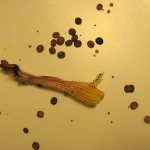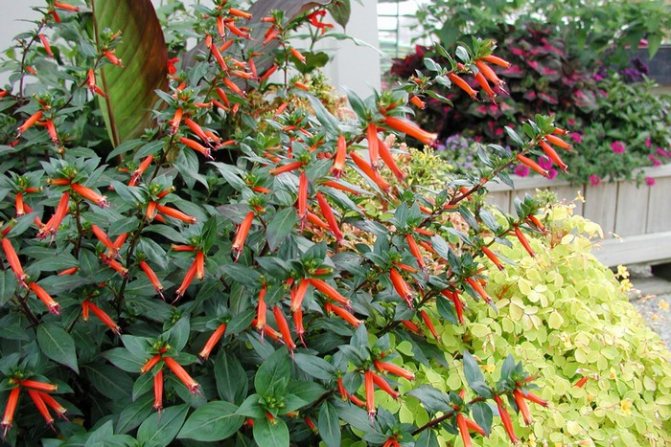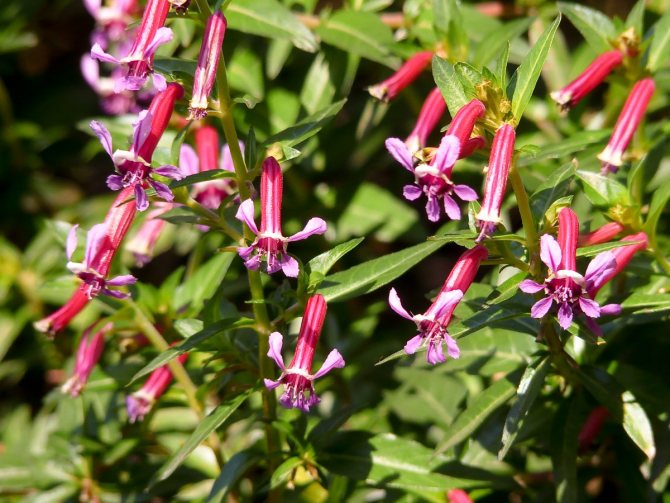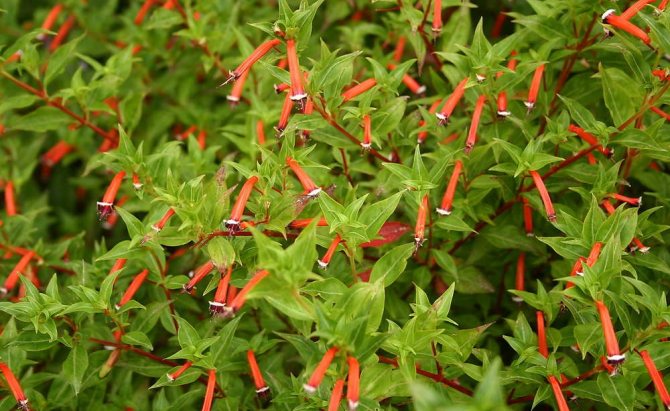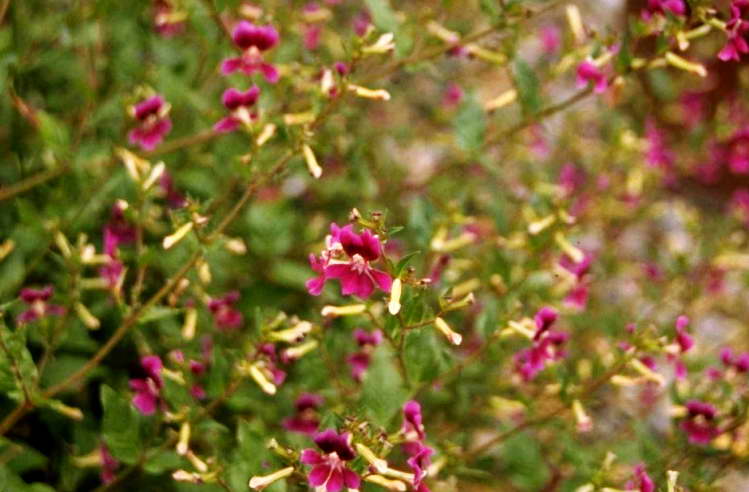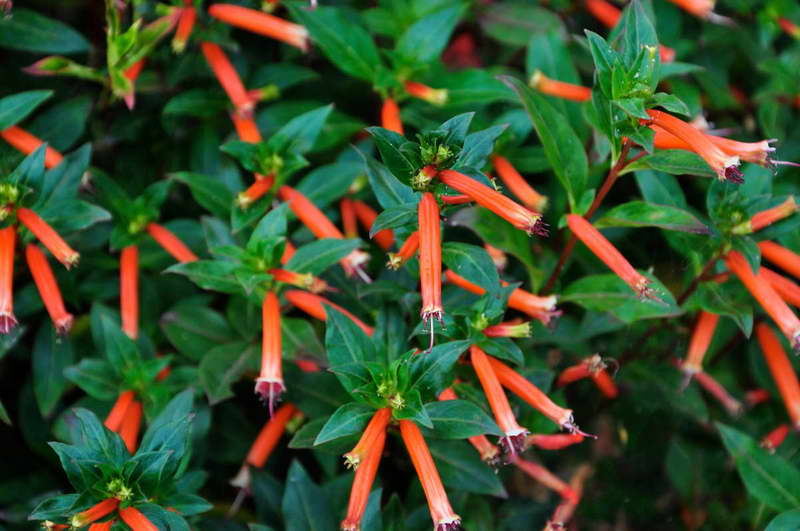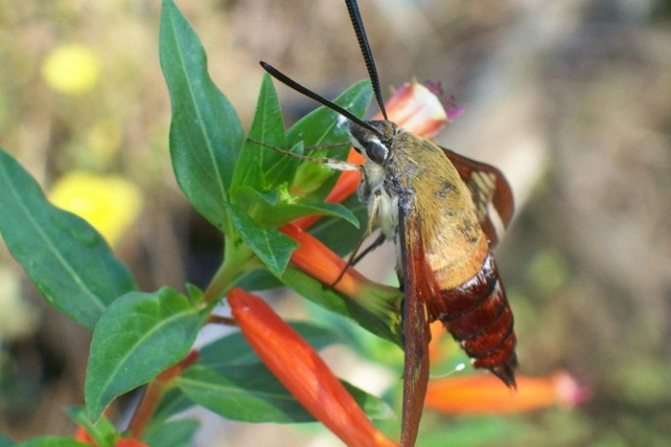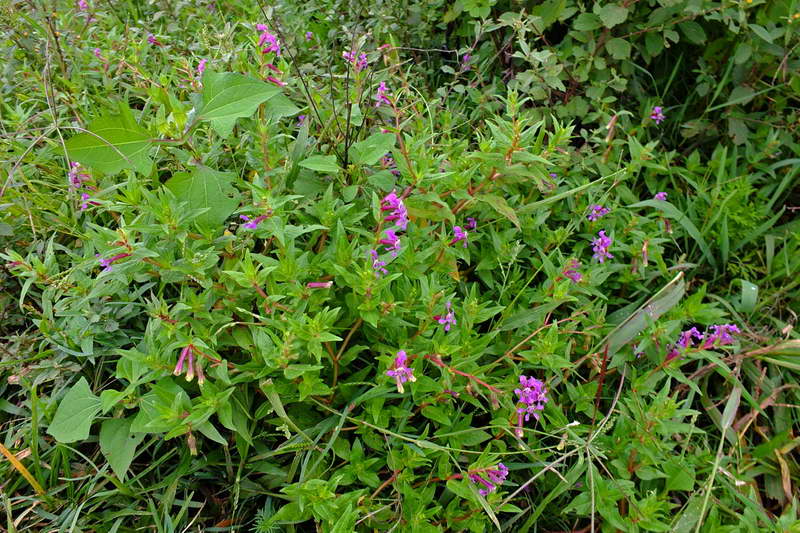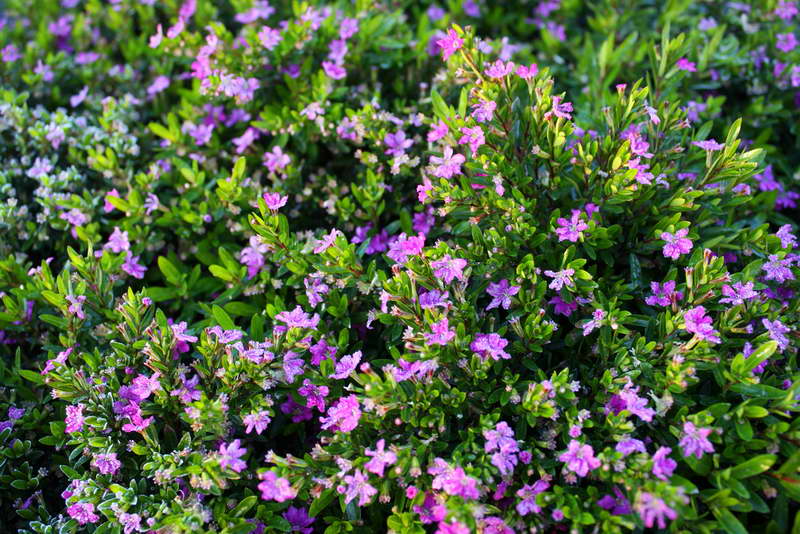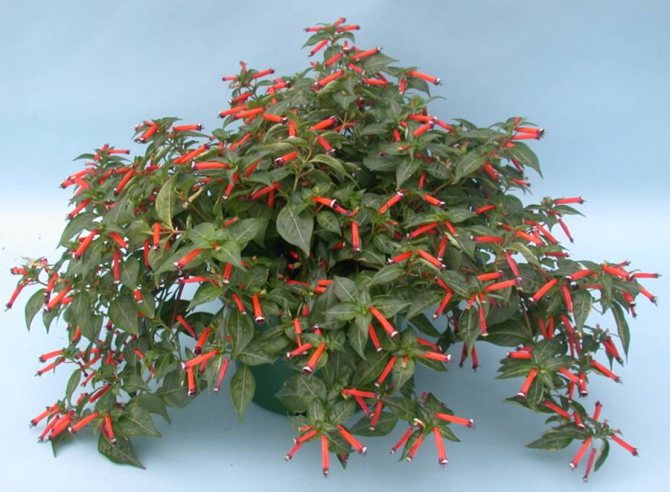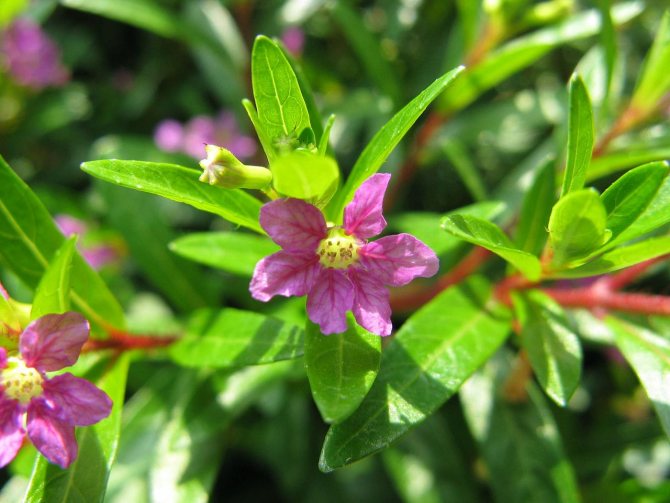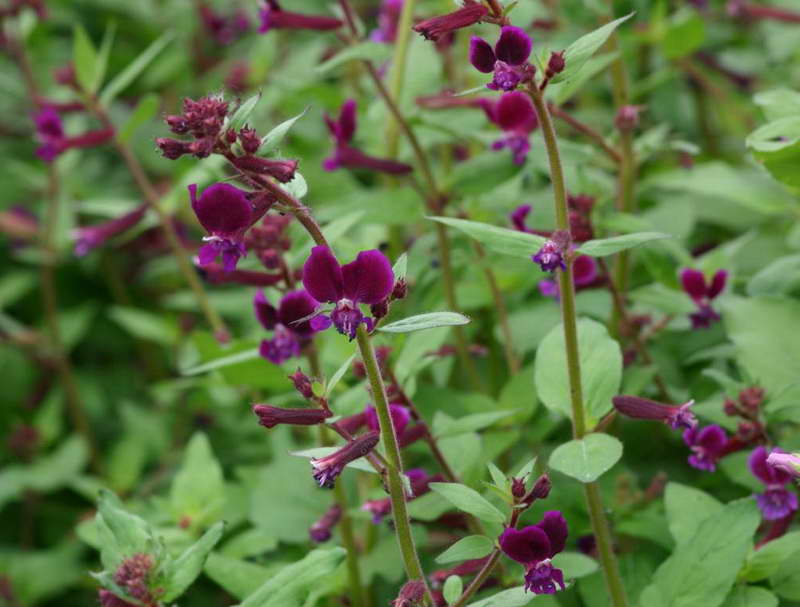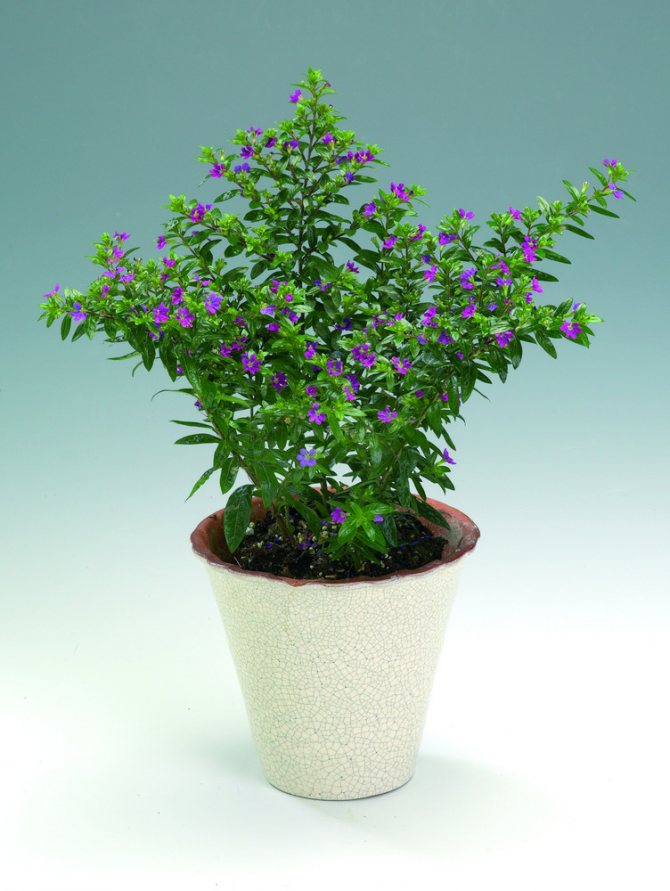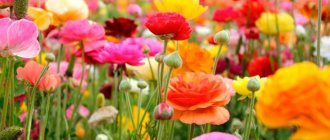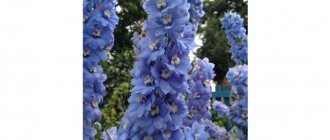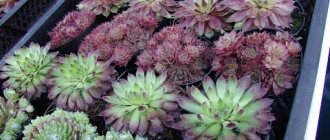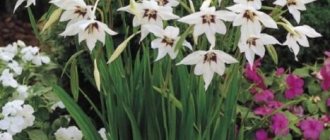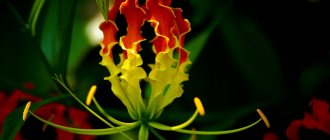Kufei
belong to the family
loosestrife
... These are Mexican plants with a Greek name. The name, however, is quite prosaic.
Kyphos
translated as "bent, crooked." The fruits of the kufei are indeed slightly curved.
In Central and South America, there are up to 200 types of kufei. Among them there are annuals reaching almost a meter in height, there are undersized dwarf shrubs and shrubs. The latter are popular in Europe as container plants.
Especially appreciated kufeya fiery red
(
C. ignea
, or
C. Platycentra
),
kufeya hyssopolis
(
C. hyssopifolia
) and
kufeya micro-petal
(
C. micropetala
). Here, these species are better known to lovers of indoor plants.
Micro-petal kufeya
shrub 30-40 cm high, with small narrow leaves, very similar to
kufeya hyssopolis
... Small flowers appear one after another, but not in the axils of the leaves, but above, above them. The flowers, that is, the calyx, are yellow, scarlet at the base, with a greenish pharynx, the stamens are red. There are six petals, but they are so tiny that they cannot be seen due to the teeth of the calyx, hence the name of the species. A lot of seeds are formed, but this plant is propagated mainly by cuttings.
Kufi bloom from March, as soon as the sun shines brighter, and until October, when its light dims. Kufi bushes grow quite quickly, they must be regularly pinched, cut and transplanted, otherwise the decorativeness of plants is significantly reduced. Abroad, this feature is successfully used, planting kufeis for the summer in large street vases and concrete containers together with different summer houses.
Annual species Cuphea
at home they are grown to obtain seeds - a source of fatty acids, including laurel, which are indispensable in the production of shampoos. And how ornamental these plants are little known, and only in recent decades have breeders seriously taken up them.
Almost all species have flowers with six unequal petals - the top two are much larger than the other four. And those who like a riot of colors and large flowers are unlikely to see anything remarkable in them. Modest kufeis - for lovers of exoticism and meditation. Or for owners of cats and dogs: unceremonious pets cannot get through a bed with tall kufei - they are unlikely to like the numerous sticky shoots.
In Arizona in the eighties of the last century, a lot of work was begun to obtain valuable decorative interspecific hybrids - scientists crossed different types of kufy. But the novelties have not yet reached Europe.
Photophilous, prefers bright lighting, but tolerates partial shade.
It is thermophilic, the optimum temperature in summer is 20-25 ° C, in winter 12-18 ° C (for room culture).
Watering is plentiful in summer, moderate in winter, drying out of the soil is undesirable.
Annual pruning in spring.
It is practically not susceptible to diseases and pests, the appearance of a spider mite is possible with dry air.
Cufea is an unusual evergreen plant native to the tropics and subtropics of South America with an interesting tube-shaped flower shape.From the Greek "Kyphos" - "bend" or "curve", kufeya got its name due to the appearance of the seeds, which are shaped like curved discs. Kufeya is a small shrub up to 50 cm tall, strewn with many elongated flowers that resemble a smoldering cigarette. That is why kufeya is popularly called "cigarette tree" or "cigarette holder". Every year, interest in the original plant only grows, today blooming kufeya can be found both in personal plots, where it is usually grown in containers, and in indoor pots on windowsills. Blooming kufeya is a real decoration of a flower bed, loggia or balcony.
| Kufeya is a low, well-branching, lush, fan-shaped shrub with dense, erect shoots. The leaves of the kufei are small, lanceolate, located on short petioles, rich green in color. Narrow tubular flowers, similar to a cigarette with a smoldering end, give a special charm to the plant. Such an original shape of the flower is explained by the fact that at home the plant is pollinated by small birds with a curved long beak - hummingbirds. Kufeya blooms magnificently and for a long time, from spring to autumn, decorating personal plots and window sills of houses and offices. It is believed that blooming kufeya is a symbol of mutual understanding between people and sets them up in a friendly, peaceful way. Therefore, the flower can often be found in meeting or work rooms, living rooms. |
Kufeya, types
There are over 200 plant species in America. There are both annual shrubs and those that delight with their lush flowering for several years. There are a huge number of subspecies, but only a few varieties of this plant are popular in our region:
- Issopolitan kufea.
Well-branched shrub, reaching a height of no more than 50 cm. Lush bush, with numerous short-petiolate leaves of dark green color. The length of the leaf is up to 2.5 cm, the width is 0.4 cm. The flowers are tubular, small. Lush bloom continues throughout the summer. There are flowers of white, pink, pale lilac color of corollas. This type of kufei prefers warmth, but also tolerates rain and windy weather well. Propagated by cuttings.
- Kufeya fiery red gel.
The brightest and most attractive variety of kufei. The branched shrub reaches a height of up to 40 cm, the shoots are straight or slightly curved. The leaves are opposite, oblong, dark green. The length of the leaf is up to 6 cm, the width is about 2 cm. The flowers are fiery red, tubular, with a small bend at the end, painted in dark purple color. Grown in a container to decorate balconies, terraces, loggias, or as an indoor flower. Gel kufeya also successfully grows in the open field in a flower garden, it is used to decorate the border. Looks great in a hanging planter, where several bushes are planted for decorative purposes. Very thermophilic, easily propagated by seeds and cuttings.
- Lanceolate kufea.
An annual, fast-growing shrub, reaching a height of up to 90 cm. Stems - A fast-growing annual plant. The stems are colored purple, slightly pubescent. The flowers are tubular, dark purple in color, collected in inflorescences, reaching a length of up to 3 cm. The flowering time is from May to October. Propagated by seeds.
- The kufeya is pale.
An annual compact and graceful shrub with dark lush foliage. It blooms beautifully with numerous small flowers of wine-red color. Looks gorgeous in hanging containers and in flowerpots in a flower garden, blooming kufeya pale to the very frost. Propagated by cuttings.
- Spread out kufeya.
The bush is low up to 40 cm, the stems are branching, falling to the ground. The foliage is dense, dark green in color. It blooms with small lilac, purple or white flowers from mid-summer. Propagated by seeds, is distinguished by high seed germination.
Plant species
In European countries, the plantation is mainly represented by the following species:
- 1 Hyssopolis kufeya. An evergreen shrub prevails in hot and humid countries. Most often this variety can be found in Mexico. The height of the plant is no more than 0.6 m. In width, the shrub sometimes grows up to 0.9 m. The oblong leaves are more like a fern, and the branches are flat and porous. During the flowering period, small inflorescences appear: lilac, white and pink, which delight the eye throughout the summer. The plant prefers shade, but for its flowering, the sun's rays are needed in a limited amount, since their excess can have a negative effect on the seedlings. The leaves will get burned, they will begin to fall off. The bush itself will begin to wither. At home, a small tree can be grown from kufei, since the branches of the plant quickly harden and acquire the properties of wood. Due to the rapid growth of the shrub, bonsai can be obtained already in the first season. The culture is easily propagated by cuttings.
- 2 Fiery red kufei plant. The most popular type of planting for flowering in the home environment. It is characterized by flowers in the form of tubes of fiery red color with a corolla of white and blue tones. It is rather a shrub. In the open field, it sometimes grows in length and width by 0.9 m. At home, a pot does not allow a plant to reach such dimensions. Therefore, 0.5 m is the maximum planting height. The color of the leaves is fiery red, they are about 3 cm long.They themselves are oval, from which flowers appear. Possesses thin and fragile shoots. This species grows quickly and does not require special care. Propagated by seeds and cuttings.
- 3 Micro-petal kufeya. The name comes from oblong, but very small leaves. This shrub can stretch up to 0.5 m. The color of the flower changes due to periods of growth. When it appears, it is yellow-cream, with aging it becomes red-orange.
- 4 Lanceolate kufea. An annual plant that grows to a height of 0.9 m. Stems are purple in color, strongly drooping and sticky to the touch. The leaves are oblong, with a pointed tip, similar to a lancet. This is where the name of this species comes from. Flowers are tube-shaped, dark purple in color. The stem is tall, purple in color. Interestingly, the two flowers at the top of the shrub are larger than the rest.
- 5 Cufea Lavey. It is a shrub that can grow up to 0.6 m in height. It is characterized by elongated leaves covered with small hairs. The flower has only two petals at the top, elongated, usually bright scarlet in color.
- 6 Pale shrub of kufei. It is an annual, small, graceful shrub with a dark, lush crown of leaves. The flowers are small, wine-red in color. The plant until the very frost looks great in flower gardens, flowerpots and containers. Planting is carried out by cuttings.
- 7 Spread kufeya. This is a short shrub, no higher than 40 cm. The branches spread along the ground. Lush foliage is dark green in color. Flowering begins in mid-summer. The flowers are small and colorful. On the bush, you can see lilac, white and purple inflorescences. Reproduction is carried out by seed, and the germination rate of this species is high.
Kufeya: growing at home
The beautifully flowering kufeya deservedly takes pride of place on the windowsills and is successfully grown indoors. Spectacular and original cigar flowers bloom profusely and for a long time, delighting with their splendor for a long time. The main advantages of an exotic flower are fast growth and easy reproduction by seeds or cuttings. Seeds of kufei germinate rather quickly and take root well. In addition, the beauty of the kufeya is not demanding in care, therefore it is ideal for amateur flower growers, as well as those who love lush luxurious plants with bright long flowering.
Location of kufei
Kufeya prefers bright rooms, it can be placed on the east or west window. The plant responds well to sunlight, the more intense the illumination, the more buds will tie on the shoots. In a dark, poorly lit room or in the shade, the kufei will not bloom, and the leaves will lose their rich color. But still, it must be protected from the scorching rays of the sun and avoided the southern windows, or use shading from the midday heat. Native to the tropics and subtropics, exotic kufea successfully grows and blooms profusely in high humidity, so the plant can even be placed in the kitchen or bathroom, where there is a light window.
Temperature regime of kufei
A comfortable temperature for kufei in the spring-summer period should be moderate, within 22-25 degrees, and in winter - from 12 to 18. At lower temperatures, kufei may die. Also, the plant must be protected from drafts.
Watering kufei
Kufea is demanding for watering, especially during the flowering period. Water the flowering shrub 2-3 times a week with water at room temperature. The soil should be well saturated with moisture, the entire earthen lump of the pot should always be slightly damp. It is necessary to monitor the condition of the topsoil and prevent it from drying out. However, the plant does not tolerate stagnant moisture, so it is important to provide it with good drainage. In the autumn-winter period, watering is reduced and becomes more moderate. Kufeya loves water treatments: a cool shower or spraying.
Planting and feeding kufei
For the rapid growth and development of kufei, it is necessary to properly prepare the soil for planting. The soil must be nutritious and fertile. For planting, you can use a universal weakly acidic soil or prepare a soil mixture from: a part of leafy soil, humus, peat and turf soil and half of river sand. Organic fertilizers or complex mineral compositions for flowering plants are used as top dressing. During flowering, once every 1-2 weeks, it is recommended to water and spray the plant leaf with a solution of mineral fertilizer at the rate of 20 grams per bucket of water.
Pruning kufei
Kufea grows very quickly, and, in a short period of time, its shoots reach their maximum height. To make the bush look well-groomed and luxurious, regular corrective pruning is necessary to form a neat compact crown. It is also recommended to pinch the tops of elongated shoots. Strong branching of kufei hyssopolis allows you to create original geometric shapes of the crown in the form of a ball or pyramid. Pruning fiery red kufei consists of removing overly elongated stems.
Transplant kufei
For kufei grown from seeds, an annual transplant in the spring into a new, larger pot is required. The size and diameter of the new pot should be 2-3 cm larger than the previous one. When the bush reaches a pot size of 25 cm, the transplant can be done less often - once every 2-3 years. It is necessary to transplant the plant into fertile soil with the addition of mineral fertilizers at the rate of:
- half of the sterilized sheet soil;
- a quarter of neutral peat;
- a quarter of pure river sand;
- 40 grams of complex mineral fertilizer for blooming on a bucket of soil.
It is very important to ensure good drainage, therefore expanded clay, broken brick or foam is placed on the bottom of the container or pot.
Do i need a kufei transplant after purchase?
Kufa is easily grown from seed, but if you bought a young plant from a flower shop, it will definitely need to be transplanted into another pot. In most cases, the root system of the copies sold in the store is protected by a special protective bag. Such a tissue bag protects the roots from injury and helps to easily separate it from the earthy coma.It must be carefully removed so that it does not lead to decay of the root system of the flower and does not interfere with the nutrition of the plant. When transplanting kufei, the method of transshipment with an earthen lump is not used; the roots must be cleaned as thoroughly as possible from the substrate that was used for transportation.
Growing kufei from seeds
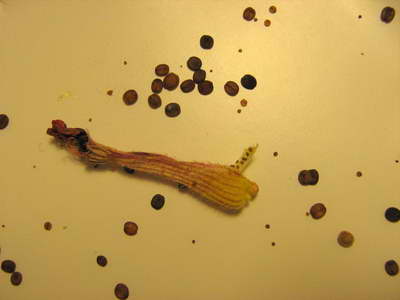
Seeds of kufei photo
When to plant
Annuals and perennials can be grown from seed, but in seedlings. We start sowing in early spring, in late February - early March. Lay a drainage layer (pebbles or expanded clay) on the bottom of the sowing container, fill in a universal soil mixture for growing seedlings (it is recommended to supplement it with perlite or wet peat) and level it.
- Spread the seeds over the soil surface, only slightly deepening, moisten by spraying from a fine spray.
- Cover with clear glass or plastic to create a greenhouse effect.
- Provide diffuse lighting and maintain the air temperature within 22-25 ° C, also raise the shelter daily for ventilation, periodically spray crops or use bottom watering (moisten in this way so that the seeds do not "drown").
- When the sprouts appear, you can remove the shelter for a while, so that they successfully adapt, in the future we grow without shelter.
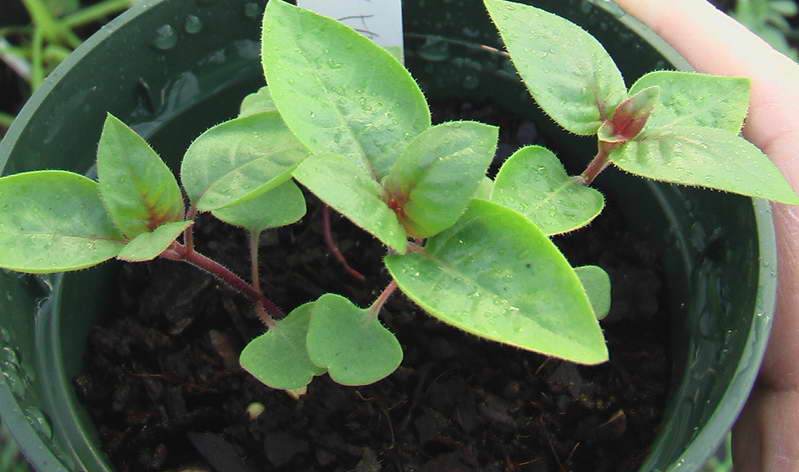

Seed kufea photo of seedlings
- Dense crops need to be thinned out, and when the seedlings grow up, plant them in separate containers.
- Seedling care consists in moderate watering, with the appearance of the third pair of real leaves, pinch the top.
Seedlings intended for transplanting into open ground need to be hardened. To do this, 7-10 days before transplanting, begin to take the plants outside, increase the time spent in the fresh air each time, until the seedlings can spend the night in such conditions.
We carry out the transplant with the establishment of real heat in your region. Dig up the site, remove weeds and debris, level the ground and make holes in accordance with the size of the root system. It is preferable to use the transshipment method. Lightly squeeze the soil around the seedling with your palms and water, keep a distance of about 25 cm between individual plants.
Planting kufei in the open field
Kufeya is a thermophilic plant, therefore it is successfully grown in the southern regions in the open field, as an annual plant. Spectacular terry bushes of kufei with lush flowering throughout the spring-summer season delight the eye and amaze with their originality. Kufeya looks exquisite in hanging pots on verandas, loggias or balconies. It also looks great in compositions with other flowering shrubs in a flower bed or as a border decoration. As a rule, outdoor kufeya is grown as an annual. It is often used as an element of landscape design and is planted in large containers, vases and pots.
Kufeya prefers bright areas of the garden with natural shade during the midday heat. The correct planting site is the key to the success of active growth and lush flowering of kufei. If the flower grows in your pot at home, then for the summer you can take it out into the garden, on the terrace, find for it a bright area of the garden where there are no drafts. In October, with the onset of significant cold snaps, the kufeya is transferred to the house to its original place. To give the shrub an attractive appearance, dried foliage and wilted flowers should be removed.
If you decide to transplant kufeya from a room pot into open ground, the plant should be pre-hardened and prepared for planting in new conditions. Transplanting into soil is carried out into fertile soil only after the end of the spring frost, in May. It is not recommended to choose for planting those places in the garden where water will accumulate, kufeya does not tolerate stagnant moisture and may die from an excess of moisture in the soil.When planting seedlings, if the plant was grown from seeds, the kufeya is transplanted from the container at the end of May, without deeply burying it in the soil. After planting, the young plant does not need special care; regular watering, feeding during flowering and removing weeds is enough.
Transplant after buying a flower
After purchasing kufei in a flower shop, it must be transplanted.
This is due to the fact that the root system of the bush is placed in a special woven bag that must be removed. It will interfere with the roots, get food and water. The roots will rot and the culture will die.
Therefore, the root system is thoroughly cleaned of the store substrate and planted in newly prepared soil. To prepare it, sterilized soil is combined, of which half of the total volume of new soil is taken, a fourth part is neutral peat, and the rest is sand. 40 g of mineral fertilizers are added, diluted in a bucket of water.
Kufeya: reproduction
Kufeya reproduces quite easily and quickly, two methods are used for this: seeds and cuttings.
Reproduction of kufei by seeds
Seeds of kufei have a slightly curved disc shape, up to 3 cm in diameter. The color of the seeds is greenish brown. They have a high germination capacity, the first shoots appear within a week after planting. Seed planting is carried out in early spring.
Propagation of kufei by cuttings
The method of propagation of kufei by cuttings is used quite often. The optimal time for planting by cuttings is spring, when the air temperature has already warmed up to 18 degrees. For reproduction, not quite lignified cuttings, whose top is cut off, are suitable. The cut should be oblique; a sharp knife is used for this. Cut cuttings must be placed in a glass of water. After about a week, the roots will appear - the stalk is ready for planting in a container with earth. To make the bush decorative, it is recommended to plant 2-3 cuttings in a pot at the same time. When the first few leaves appear on the cuttings, pinch the top of the shoot.
Reproduction
Kufeya is transplanted annually into fertile, oily soil. The containers must have good drainage, allowing the soil to be breathable and ideal for water drainage.
Kufea can be propagated by seeds and cuttings.
- 1 Seed propagation. At home, in early spring, seeds are sown in a pre-prepared tray with a substrate. The initial breeding season will take place here. The seeds are immersed shallowly. If the room is brightly lit, cover the pallet with dark paper or film. As soon as the sprouts appear, the tray is placed on the windowsill, where there is enough sunlight. When the first leaves appear, the sprouts can be planted in separate containers. The soil should be moistened regularly. After waiting for the time when the seedlings grow up a little, you can distinguish strong and weak shoots. Strong shoots are transplanted into separate pots with bottom diameters of more than 11 cm. And weak shoots can be removed.
- 2 Cuttings. The method is used to grow plants outdoors. The cut stalk is placed in water. Moreover, the cut itself must be oblique. After a week, the cutting will take root. After the cuttings with roots are well strengthened, they can be transferred and planted in open ground. 2-3 cuttings with a root system are placed in each hole.
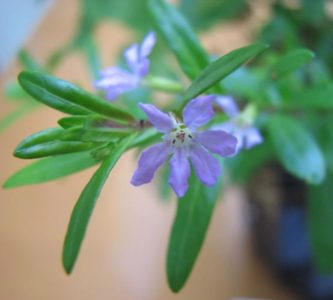

Diseases and pests of kufei
Kufeya is most often prone to fungal diseases and gray rot, which affects the equine system of the plant. The appearance of a fungal disease may be the result of excessive watering or stagnation of moisture in the soil. The clear signs of the disease are:
- the appearance of dark gray spots on the leaves of the plant;
- decay of shoots occurs;
- decay of the root collar.
- Fungicides are used to combat fungus and gray mold.
- Powdery mildew. Looks like white bloom on leaves and stems.The fungus appears in kufei when the temperature regime is violated, due to improper care of the plant. For the treatment of the disease, fungicides are used.
- Sometimes you can notice the appearance of yellow leaves in a plant - this is a clear sign of a lack of iron in the soil. In this case, it is necessary to add this microelement to the diet of feeding the shrub.
Among the pests attacking the plant, one can distinguish:
- Spider mite
... On the leaves and branches, you can see a white thin cobweb, which is left by a spider mite. The reason for its appearance is the very dry air in the room where the kufeya is located. To get rid of the pest, use a soapy solution of potassium soap (20 grams of soap in 1 liter of water). Gently wash the leaves with a soft sponge and soapy water. Spider mites are also sprayed with insecticides.
- Shield.
Brownish bulges are clearly visible on the leaves - these are the shells of the pest. To get rid of the scale insects, use a soapy solution of potassium soap and mechanically scrape the insects off the leaves of the plant. If you do not get rid of the scale insect mechanically, apply insecticides. - Thrips
... When infected with thrips, the leaves of the kufei are deformed, the ends become serrated. To combat the pest, a mechanical method of washing the bush under a stream of cool water is used, and then with insecticides.
Possible problems in growing kufei
If you follow all the agrotechnical rules for the cultivation of kufei, there should be no special problems. But if the care does not meet the requirements, the flower begins to give signals, its external data becomes unattractive.
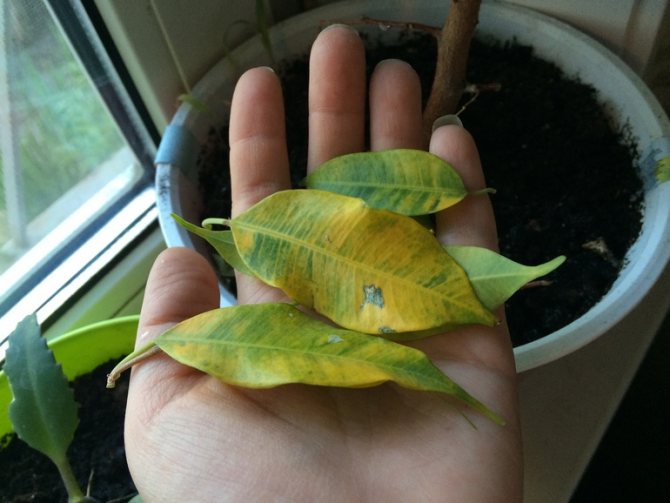

Yellowed leaves
- Drops buds and leaves
This reason may appear due to insufficient amount of sunlight. At best, the flowering will be poor, at worst, the plant will independently shed the buds that have set.
- Leaves turn pale
If the leaf turns pale or yellow, there are two solutions to the problem. In this case, he either does not have enough iron, or the watering was carried out too abundantly or often. It is worth reducing watering and applying the necessary fertilizers.
- The tips of the leaves dry
In this state of affairs, we can talk about insufficient watering, or the presence of strong drafts. It is necessary to increase watering, after it water should remain in the pan, after 10 minutes it must be drained. If you are worried about drafts, it is better to move the pot to another place and carry out sanitary pruning.
- The lower leaves fall
In addition to the dropping of the lower leaves, they can also become covered with brown spots. Most likely, rotting of the root collar occurs. The plant suffers from a fungal disease, urgent fungicide treatment and sanitary pruning are needed.
Pests
In rare cases, the scabbard and spider mite attack the kufeyu. If there are ticks in the container, then a characteristic thin white cobweb can be observed on the plant. In such a situation, it is enough to treat the plant with a sponge dipped in soapy water. If the case is neglected, then chemical treatment will be required.
If convex bumps of a brown hue were found on the leaves, then we can talk about the appearance of a scale insect. A soapy solution and a brush will mechanically remove these insect shells. Additionally, you can carry out insecticidal treatment.
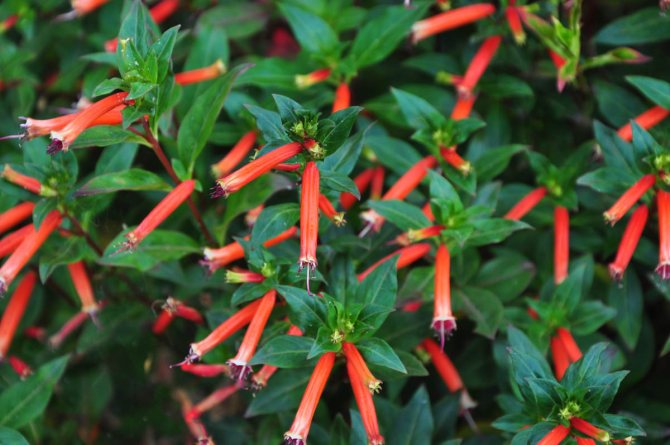

Kufeya in the garden
With proper care of exotic kufeya, no problems should arise with it. You should not start growing a flower for novice gardeners, they may not be able to cope with this plant, because it is not so easy to care for it. We must not forget about watering, fertilizing and obligatory pruning, then you can expect excellent flowering of the shrub for many months.
Kufeya, photo
A delicate and unusual plant with the name of kufeya fully justifies it. Indeed, translated from Greek, the word means - curved. Plants got this name because of their irregularly curved fruits.Cufea grows in South America, which affects its love of abundant sunshine. Today, more than two hundred and fifty species of this plant are known, some of which are perennial, and some are annuals.
For ornamental purposes, the plant is most often grown as an annual, but some have successfully enjoyed the ornamental properties of Kufei at home for many years. In the open field, the flower tolerates winter well in warm regions, so it can also be grown in the same place for several years. The plant blooms with very beautiful flowers that fascinate and attract views, especially since the flowering period is quite long. The first flowers appear already at the beginning of March, while the bush can stand in flowers for the whole of September.
Kufeya looks spectacular in flower containers that decorate covered terraces, loggias or flower beds.
In some regions, the plant is of industrial importance - laurel acid is produced from seeds. While the ornamental plant Kufeya began to be used quite recently, many new interesting species and varieties have appeared in a short time.
Frost resistance of kufei
Kufeya is at the same time in a series of indoor and garden plants. In the conditions of central Russia, annual species and varieties are seasonally grown in open ground, and perennials are cultivated as indoor plants. Vases with flowering bushes for the warm season become a decoration of the garden, veranda, balcony. In October, bring the containers with the plant into a cool, but closed room, and with the onset of frost, return them to their usual place (room). Kufeya is capable of wintering in the open field only in the southern regions of the country. The most frost-resistant varieties can withstand a maximum of 12 ° C below zero.
Even at home, kufeya became popular in gardening some 15 years ago. In Arizona, in the late 80s, active work began on the development of new interspecific hybrids, but the results of their work have not yet reached the countries of Europe. It is not difficult to grow kufeya, but due to its heat-loving nature, there are difficulties.
What is Kufeya
Among the most popular one-year-old species is the Spread Kufa, which can grow up to fifty centimeters in height. Flowers can be of different shades, from white to lilac. Differs in rapid development and inaccessibility of planting material.
Another famous annual is Pale Kufeya, a distinctive feature of which are small red flowers. The main breeding method is cuttings, and flowering begins in June. The species does well in flower containers, especially hanging pots.
The ornamental bush of Issopolistnaya Kufei keeps its shape perfectly in all weather conditions. The flowers are small with a pinkish tinge. Requires warmth, sunlight and regular watering. The main breeding method is cuttings, which can be purchased in early spring.
The spectacular ampelous appearance of Kufei received an equally spectacular name - "The Burning Fire" due to the abundance of red flowers during the flowering period. For the formation of a small decorative bush requires appropriate pruning. Duration of flowering from July to October.
A very tall plant with purple flowers, known as Lanceolate Kufea, propagates exclusively by seed. It has a long flowering period, which is traditional for this plant.
We will tell you in more detail what Kufeya is, planting and care, where to grow and what to fear.
Pruning
Kufa grows very quickly. For a short period of time, it stretches to its maximum height. If you want to refine the flower, give it an elegant and well-groomed look, you need to properly prune and pinch the shoots. In a fiery red variety, elongated shoots are simply cut off.
To trim the hyssopolis look, you need to work a little if you want to give the bush the shape of a ball or pyramid. Pruning is carried out in early spring, and ends before the growing season and flowering. For more successful growth, the stems need to be shortened by a third. Similar actions are carried out for pruning perennial plants.
How to care for
The best place to plant a plant will be sunny and warm places. If we are talking about the southern regions of our country, then Kufeya may well be grown in flower beds as an annual plant. A flower on balconies or terraces, planted in containers, looks good. It is used both for single accents and in group plantings. Flowers growing indoors can be taken out into the fresh air for the summer, and brought into the house in the fall.
Kufeya requires careful care for its appearance: pruning withered flowers, dried leaves and shoots.
Some species of this plant are demanding for watering, which must be carried out quite often and abundantly. However, after the summer period, its frequency is recommended to be reduced. Only during the flowering period it is necessary to monitor the moisture content of the soil cover, while with a lack of moisture, the flower quickly sheds its buds.
In room conditions, Kufeya feels great, but should spend the winter at a temperature of no higher than five degrees. With the onset of spring, a thorough pruning is necessary to enable young shoots to develop.
The flower responds well to organic matter, which can be applied during the spring and summer period in the form of an aqueous solution. You can use fertilizers for leafy and flowering plants, which are sold in specialty stores.
When and how kufeya blooms
The flowering period of kufei can be quite long if all the rules of agricultural technology are followed. Good care will produce abundant flowering.
- Types of flowers
The appearance of flowers depends entirely on the type and variety of kufei. Corollas can be painted not only brick-red, but also creamy white.
Important! At the same time, red flowers are formed earlier than anyone else.
- Flower shapes
The flower shape is tubular with a dark tip, it is the most common and resembles a kind of light. The second most popular form is an inflorescence with petals of the same size and a pronounced pistil.
- Flowering period
This plant blooms from March to October. For almost six months, the site or loggia will be decorated with beautiful flowers.
- Changes in care during flowering
In no case should pruning be carried out during the growing season. Watering is slightly reduced, but it is impossible to allow the soil to dry out. Do not forget about fertilizing.
Attention! Do not use formulations with a large amount of nitrogen, otherwise only the green crown will actively grow.
Reproduction methods
The most effective propagation method is cuttings, which are best done in the spring. The air temperature should be at least eighteen degrees. To get a lush bush, it is better to plant several cuttings in one container, and pinch after the appearance of the third leaf.
Some people grow Kufeya by seed method, for which the seeds are sown in March. For good germination, you need to achieve a greenhouse effect by covering the planting with film or glass. After a while, the seedlings can be transplanted into separate pots for self-cultivation.
Kufea (Cuphea) are perennial and annual grasses and shrubs belonging to the Derbennikov family. This numerous genus consists of about 250 species and lives in the American tropics and subtropics. Some kufei are cultivated to extract oil from the seeds, while others are cultivated as honey plants and ornamental plants.
Description of kufei
These are Mexican plants with a Greek name. The name, however, is quite prosaic. Kyphos translates as "bent, crooked."The fruits of the kufei are indeed slightly curved. In Central and South America, there are up to 200 types of kufei.
Among them there are annuals reaching almost a meter in height, there are undersized dwarf shrubs and shrubs. The latter are popular in Europe as ornamental plants.
They bloom starting in March, as soon as the sun shines brighter, and until October, when its light dims. Kufi bushes grow quite quickly, they must be regularly pinched, cut and transplanted, otherwise the decorativeness of plants is significantly reduced.
Abroad, this feature is successfully used, planting kufeis for the summer in large street vases and concrete containers together with different summer houses.
Annual species of Cuphea are grown at home to obtain seeds - a source of fatty acids, including laurel, which are indispensable in the production of shampoos. And how ornamental these plants are little known, and only in recent decades have breeders seriously taken up them.
Almost all species have flowers with six unequal petals - the top two are much larger than the other four. And those who like a riot of colors and large flowers are unlikely to see anything remarkable in them. Modest kufeis - for lovers of exoticism and meditation. Or for owners of cats and dogs: unceremonious pets cannot get through a bed with tall kufei - they are unlikely to like the numerous sticky shoots.
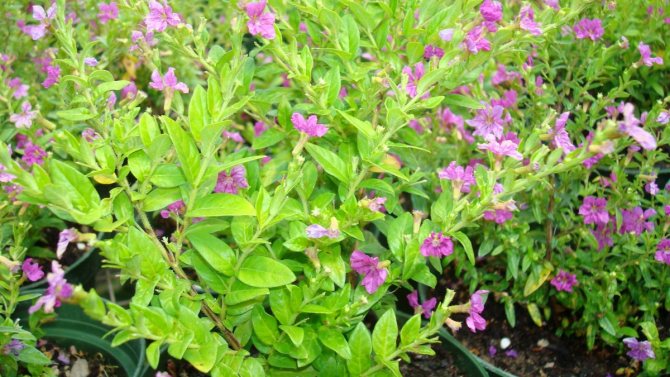

Hyssopoly kufea (Сuphea hyssopifolia). <>
general description
Kufeya is a fast-growing plant with slightly curved, smooth, narrow, dark green leaves. Stems up to half a meter long, erect or ampelous.
It blooms from spring to autumn with red, white or purple flowers of the original shape, 2-3 cm long. The shape of the bud of some species resembles a smoldering cigarette, for which it received the name "cigarette tree". Due to the large number of species, flowers can be of various shapes and sizes. Usually large-flowered species do not bloom very profusely, and small-flowered species are almost entirely covered with buds under favorable conditions.
What does kufeya look like?
Kufeya is a lush fan-shaped evergreen shrub. The plant belongs to the Derbennikovye family. The shoots of the flower are erect, the leaf is of medium size, painted in a deep green color.
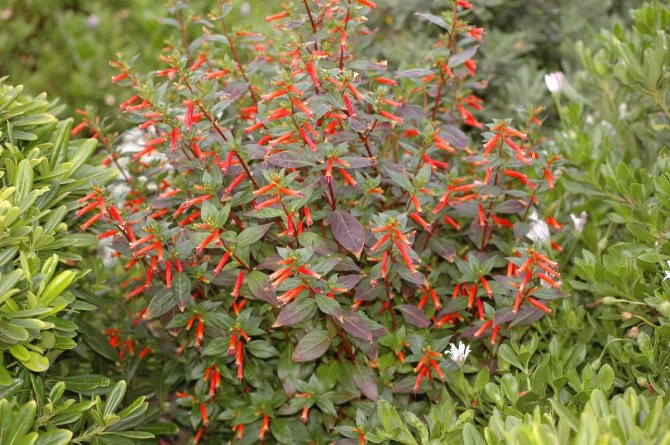

Kufeya in landscape design
The kufea flower is of Mexican origin. But the name has Greek roots and means "bend" in translation. Outwardly, the plant is fully consistent with its name, the leaves of the kufei have distinct curves. It is generally accepted that if this plant bloomed in the house, then peace and mutual understanding between the residents reign in it. For this reason, the flower is often placed in hotels, meeting rooms or other work spaces.
Important! The peculiarity of kufei in its inflorescences is that their tubular shape resembles a cigarette with a smoldering tip.
This feature can be explained by the fact that the smallest birds in the world with a thin, curved beak - the Hummingbird - pollinate the kufeyu in the homeland. The plant blooms magnificently, this period lasts from spring to autumn. During the whole warm period, houses, plots and windowsills are decorated with magnificent kufei flowers.
Types of kufei
- - an annual flower 90 cm high. Red tubular flowers with a purple or white limb. Leaves are light green.
- Kufeya Fiery Red
- bush up to 35 cm in height with red tubular flowers.
- - an annual hybrid species with red flowers 30 cm high.
- - an annual branch up to 40 cm high with branching creeping stems. Flowers are white, lilac or purple in color.
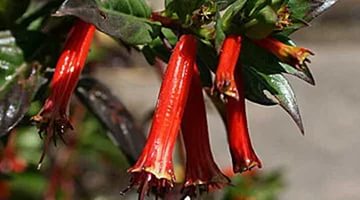

- Kufeya Issopolistnaya
is a bush up to 50 cm high with branching stems and numerous elongated leaves. The flowers are white, pink or reddish-purple, up to 2 cm in diameter.
- Kufeya Pale
compact bush with many red flowers.It is widely used as a houseplant.
Common species and varieties
The genus of kufei has more than 250 species, so you shouldn't be surprised if you have to see completely different plants under this name. Perennials can be not only artisanal, but also herbaceous type, with erect or curly stems. In Russia, certain varieties are usually grown that do well in any type of container.
Kufea hyssopolis
Perennial chrysanthemums - planting and care in the open field
Hyssopolis kufea is a species that has a special fresh look. These bushes reach a height of half a meter.
The shoots are actively branching, the leaves are small in size, the length does not exceed 3 cm, of a bright green hue. For kufei, such flowers are completely atypical.
The shade of the inflorescences is lilac-pink, the petals are of the same size, in the middle there is a corolla with a diameter of 1 cm.
Important! These inflorescences do not produce seeds, so they can be propagated exclusively by cuttings.
Kufeya Dynamite
Kufeya Dynamite is a variety of hyperali kufei. This bush can be easily shaped by pruning to create the desired shape. For this reason, in addition to growing in containers, the plant is more preferred to be planted in open ground.
Abundant flowering in the warm season is truly capable of decorating any, even the most unattractive, site. The shrub prefers warm weather, but winds and rains are not particularly scary for him.
Kufeya fiery red
In indoor conditions, the growth of the plant reaches 40 cm, its stems are quite plastic. You can form an ampelous plant or a bush from it. The sheet has a smooth surface, elongated and narrow shape.
Inflorescences are elongated bright red tubules. These flowers have a black and purple petal at the end. Not only thanks to the inflorescences, but also to its unpretentious properties, the plant has taken root well in indoor cultivation.
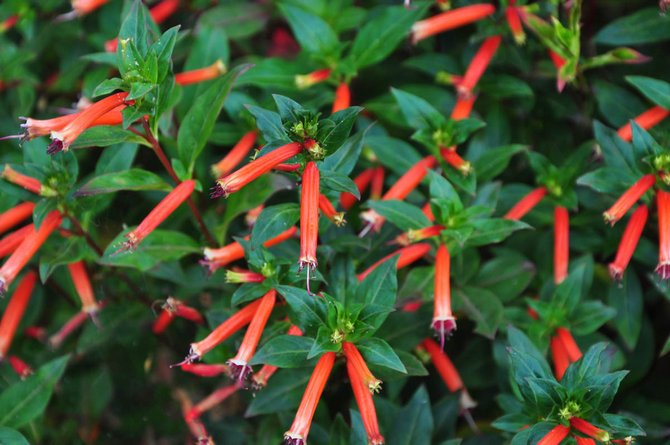

Fiery red kufeya
Kufeya Gel
This variety belongs to the fiery red species. External data attract many florists.
In a container, this plant grows beautifully and decorates balconies, loggias, offices and other premises. It feels great not only in containers, but also in flower beds of the gel variety. The plant can be planted in personal plots, usually they are decorated with borders.
Caring for kufei
The plant is more suitable for flower beds, but because of the beauty of the flowering bushes, it is successfully grown as a pot plant. In indoor culture, kufeya grows quickly and can reach a size of 40-60 cm both in height and in width. It is grown as a bush or ampelous plant.
Temperature and lighting
- the plant needs good lighting, but it must be protected from direct sunlight at noon. With a lack of light, flowering will be poor or not at all.
In summer, kufeya will grow at normal temperature, and in winter it should be reduced to 10-18 degrees, but not lower than 8. In summer, the plant can be taken out into the street or balcony, but remember that it does not like drafts very much.
Air humidity and watering
- the plant should be watered very abundantly, draining the water from the pan after 30 minutes, but between watering the soil in the pot should dry out slightly. In the fall, watering is gradually reduced. Good drainage is needed, since moisture stagnation at the roots is unacceptable.
Every other day, the kufeya needs to be sprayed, especially in summer or if it hibernates in a living room with dry air. Sometimes it needs to be rinsed in the shower.
Fertilization and feeding
- during the growing season, twice a month with fertilizers for decorative flowering plants.
Soil and transplant
- suitable soil for ornamental flowering plants, you need drainage and a pot of regular shape. Young kufeis are transplanted annually, and adult plants are transplanted in a slightly larger dish in spring, when they braid the entire earthen lump with roots.
Flowering and pruning
- blooms profusely from the first year of life in June-November.Kufeya grows very quickly and reaches its maximum size in a year. In early spring, as soon as new leaves appear, it is cut off by two-thirds. Throughout the season, young shoots pinch, strongly - if you grow it in the form of a bush, a little, only so that more side shoots are formed - if it grows like an ampelous plant.
If during the winter the plant has lost its decorative effect, you can throw it away by first rooting the apical cuttings. They will bloom at the same time as an adult plant. In summer, the plant can be planted in a flower bed, and in autumn it can be brought indoors.
Success secrets
The plant is very light-requiring, even a certain amount of direct sunlight is allowed. In the summer, the tub with Kufeya can be placed on a balcony or an open veranda, in a place protected from a draft. In winter, the temperature should not drop below + 10 ° С.
Watering is needed abundant, every three to four days. In summer, the soil should always be moist; in winter, the plant is watered as the top layer dries. However, stagnant water is unacceptable. Fertilizers during flowering are added to water for irrigation, every two weeks. Regular spraying is also useful, especially if it is not possible to place Kufeya away from heating appliances.
Reproduction of kufei
Kufeya is propagated by cuttings or seeds.
Vegetative propagation
In March-April, during pruning, cuttings are taken with a length of at least 7 cm, the lower leaves are cut off, the cut is treated with a root formation stimulator and planted in a sand-peat mixture. The planting is covered with a transparent film and rooted at room temperature, regularly moistening and airing.
After rooting, the cuttings are planted in pots in several pieces for greater decorativeness. Kufa can be successfully propagated by placing its branches in a glass of water.
Seed reproduction
Seeds of kufei have poor germination, in order to get several plants, you need to sow quite a lot of them. In the spring, scatter the seeds over the surface of the soil, lightly press them, spray from a spray bottle and cover with glass, without sprinkling with soil on top. Place the container with the inoculation in a bright place with a temperature of 18-22 degrees, moisten and ventilate regularly.
Remove the glass after sprouting, and when they grow a little, unpack it into small cups.
How kufeya multiplies
Kufea is propagated by cuttings and seeds. If any of the propagation methods produced a strong and healthy plant, it can be safely planted in open ground.
Germinating seeds
Seeding instruction:
- The seeds of the plant are tight, they have poor germination. The seed is spread on the soil surface. Do not sprinkle it with earth, you can just push them a little into the ground.
- The containers must be covered with foil and placed in a warm place.
- Plentiful, but infrequent watering is carried out.
- The picking should be carried out after the appearance of the fifth leaf.
Rooting cuttings
Cuttings for propagation are best cut in late spring. Rooting them is successfully obtained using phytolamps.
The main thing is that there are at least 2 knots on the handle. To begin with, the cutting is planted in the sand and the container is covered with a film. Don't forget about watering.
After rooting, the cuttings can be safely planted in different containers.
Air layering
Those varieties of kufei that have air layers can be propagated with their help. To do this, it is important to cut off the desired section of the shoot, process it, moisten it and wait for the roots to appear in this place.
The cut is cut at a distance of 1.5 cm below the cuff and planted in the substrate.
For reference: this breeding method is practically not used for kufei.
Pests, diseases and possible problems
- Kufea can be affected by aphids and spider mites. Treat it with insecticide.
- The plant can rot if it is regularly poured.
- Leaves may fall off if the kufeya is standing in a draft.
- Gray spots on the leaves can signal the appearance of fungus or gray mold - cut off the affected parts and treat the plant with a systemic fungicide.
- Kufa is prone to chlorosis - if its leaves turn yellow, but remain elastic, pour it with iron chelate, or even better, spray it on the leaf.
Otherwise, kufeyu (Cuphea) is called a cigarette tree. Usually it is grown to decorate the territory, but it is also used to obtain laurel acid.
In the middle lane, kufei grows for only one year, only with warm winters it can live longer. Therefore, if you want to preserve the plant for several years, it is worth growing it indoors, and not in the garden.
Sowing kufei
The name kufeya (Kyphos - "bent, crooked") owes its name to the shape of the seeds.
Kufi seeds are curved discs, greenish-brown, up to 3 mm in diameter, light (about 300 pieces per 1 g), sprout in 5-7 days. During germination, a sticky substance is released, and if they lie close to each other, they form something resembling a cake, from which it is difficult to pull out a single seed.
The seeds are light-sensitive - they sprout faster in the light, so they should not be covered, it is enough to slightly press into the soil. The optimum temperature for seed germination is 20–22 ° С. In low light, the seedlings stretch out, as they say, right before our eyes. They need to dive into deep containers or into ordinary pots and boxes, but slightly at an angle. For the reasons described above, the seedlings should literally set aside a place in the sun, otherwise they will later have to pour soil under the cotyledon leaves so that the plants do not fall when watering.
Seedlings are planted in late May - early June, it can be a little deeper than she sat in the box. No special care is required - just make sure that the plants are not damaged by late frosts, and weed out the weeds in time.
Rich or moderately fertile soils, regular watering (infrequent but abundant), fertilizing with complex fertilizers - that's all these plants need. A bright place is preferable, but a slightly shaded place will also work. Only damp corners of the garden are not suitable, where there is no air movement and powdery mildew can attack the leaves of the kufei.
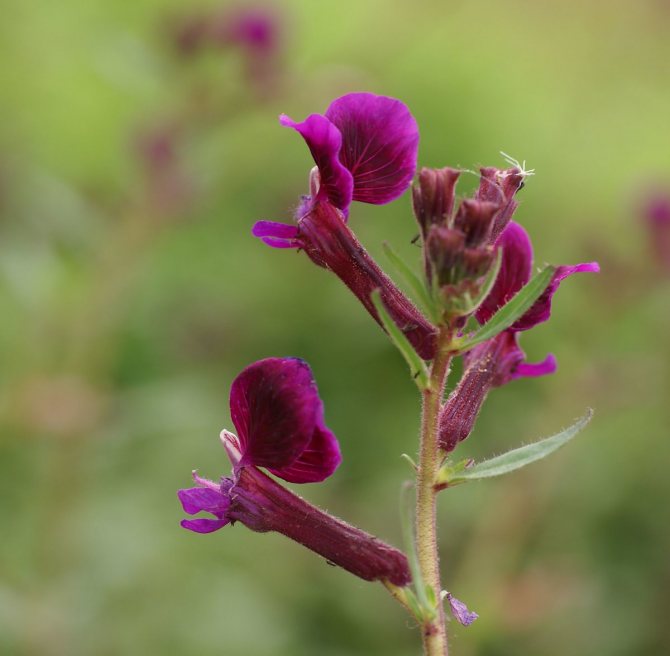

Prostrate kufea (Сuphea procumbens). <>
Botanical description
The plant belongs to the Lythraceae family.
A feature of this culture is the long flowering period, which lasts from March to September. In cooler climates, this gap shrinks slightly. Although if kufeya is grown in the house, then it blooms for a very long time.
The plant is compact in size. The shrub grows to a height of 50 cm. The culture lends itself well to pruning, so it can be given any shape.
The branches of the kufei are strewn with small oval-shaped leaves with a pointed tip. They are glossy with a dark green color.
During flowering, many small flowers are formed on the bush. Their size rarely exceeds 3.5 cm. The color can be yellow, pink-red or purple.
Growing problems
Difficulties in growing kufei are rare. But sometimes non-compliance with the conditions of detention leads to a decrease in decorativeness. For your convenience, the table contains the main difficulties that flower growers have to face.
Table - Problems in growing kufei
| Problem | What is the reason | Necessary measures |
| The appearance of dark spots on the leaves | - Lack of light in winter; - decay of the root system | - The use of artificial lighting with a lack of natural light; - inspection of the root system; - removal of decayed areas; - transplant |
| Falling leaves | - Sharp temperature drops; - prolonged heat or cold | - Normalization of the conditions of keeping kufei; - maintaining the optimum temperature for the plant |
| Yellowing of leaves | - Excess light; - the appearance of pests; - drying out of the soil | - Inspection of the plant for the presence or absence of pests; - shading from the summer sun; - regular, abundant watering |
| Fall of the lower leaves | - Lack of food; - too tight a pot | - Plant transplant with soil replacement; - application of mineral fertilizers |
| Falling buds | - Drying out of the soil; - frequent drafts; - sharp temperature drops | - Watering as the surface of the substrate dries; - keeping in a warm, draft-free place |
Seed propagation, planting and caring for kufei in the open field
Planting kufei is acceptable for areas with a warm climate. In central Russia, it is better to plant this plant at home, since it does not tolerate cold well. If the winter is frosty, then the kufeya should be grown in flowerpots, which will be taken out into the street only in summer.
Plant propagation is carried out by seeds. The optimal time for this is late March or early April. The seeds are planted in small cups, placing 1-2 seeds in the soil. Make small holes at the bottom of the containers. The soil is harvested from peat, humus, leaf and sod type land, as well as river sand. All these components are mixed and placed in prepared containers.
The seeds are immersed in the soil to a depth of 3 cm. The containers are covered with glass or foil and placed on a well-lit windowsill. Growing temperature should be at least 22 degrees. If everything is done correctly, shoots should appear in a week.
In early summer, the sprouts are moved into open ground (in warm climates) or into larger containers. In areas with cold winters, the kufeya should be taken outside only for the summer, and kept at home the rest of the time. If the climate is warm enough, then you can choose a well-lit place - in the southern part of the garden or vegetable garden, and transplant the plants there. It is advisable to protect shrubs from drafts. The soil should be neutral in acidity.
Young plant of kufei hyssopolis
Sometimes kufeya is propagated by cuttings. This is done with the same requirements for lighting, temperature and soil composition. The only difference is the larger size of the planting containers. When grafting, the plant must remain in place for at least six months, so you need to provide sufficient area for its development.
The optimum temperature for growth is from 18 to 25 degrees Celsius. This regime should be maintained throughout spring, summer and autumn. In winter, kufeya requires a decrease in temperature, but even at this time it should not be below 12 degrees. Shrubs must be protected from drafts, otherwise they may lose their leaves.
The flower prefers above average humidity as it is a tropical plant. Therefore, you need to water the culture at least 2 times a week. Do not allow the topsoil to dry out. When caring for kufei at home, water the shrub until water flows out of the holes at the bottom of the container. But waterlogging should not be allowed, so drainage is required. Be sure to spray the leaves and inflorescences. In winter, the flower is dormant, so you can water it 3-4 times a month.
The plant loves mineral-rich soil and needs private feeding. Fertilizers should be applied during flowering. Complex preparations containing nitrogen, phosphorus and calcium in equal proportions are suitable for him. Also on sale there are preparations for feeding leaves and inflorescences, for spraying shrubs. They should also be used - about once every 2 weeks.
Kufa is fast growing, so it should be cut off. There are no special rules - it is simply supposed to shorten shoots that are too long, which will allow to shape the bush.
Transfer
It is recommended to replant young shrubs every spring. This is necessary so that the plant can fully form. Therefore, during transplantation, it is necessary to take a pot larger than it was before. After the capacity reaches 25 cm in diameter, you can transplant kufeya less often - once every 2-3 years.
The composition of the soil during transplantation should be the same as when planting seeds or cuttings. Drainage should also be carried out using foam, expanded clay or other material. Care must be taken with the roots - damage is undesirable. After the procedure, the flower needs to be watered and fertilized.
Pruning kufei
Pruning is a must every spring. At this time, it will be possible to give the crown a good shape and the required dimensions.
- The fiery red kufeya must be cut so that only long branchy shoots are shortened.
- Hyssopolis kufeya will have to be shaped much more carefully in order to make an attractive crown.
In the last days of March, 2/3 of the shoots should be removed, this is how growth and vegetation are stimulated.
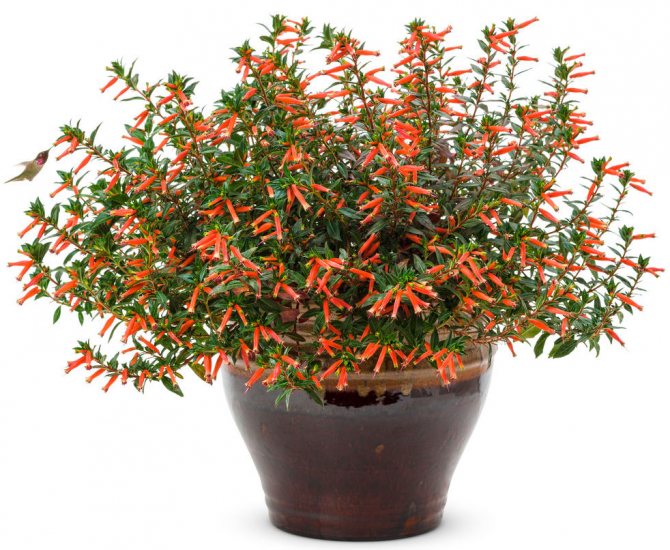

Formed kufei bush
From the history of appearance
It is not known for certain how and when kufeya migrated from the vastness of America to European garden plots. Despite the fact that it is impossible to find a grower who would not have heard anything about the shrub, the plant is still considered a great rarity and a flower for collectors.
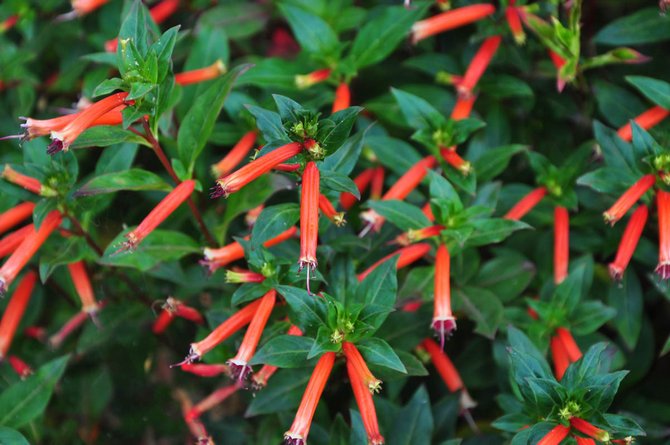

Kufeya is a very unusual flower
Despite this, thanks to the development of the sphere of industrial floriculture and the introduction of fundamentally new methods and techniques in breeding, the popularity of kufei is growing. So, for example, recently there has been a particularly high demand for the ampelous plant species.
Basic rules of care
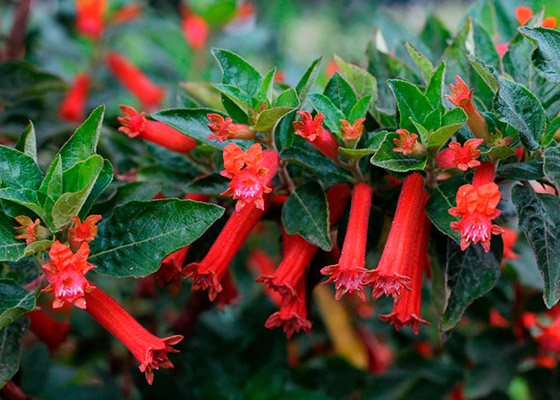

The optimal summer ambient temperature for growing kufei is between 18 and 25 degrees. In winter, perennial varieties require a lower temperature, from 12 to 15 degrees. The plant successfully tolerates colder conditions, but in this case it will bloom much later. There are several frost-resistant varieties that can withstand cold temperatures down to minus 12 degrees.
Kufeya grows well only in well-moistened soil. Water it abundantly, at least two to three times a week, and on very hot days, daily. It is especially important to monitor soil moisture during the flowering period. If there is a lack of moisture, the flowers on the bush will be less, they will not be lush. The soil should be saturated with moisture in such a way that the entire root system of the plant is in a moist environment. At the same time, the gel does not tolerate stagnant water around its roots, which is saved by drainage.
In winter, reduce watering by three times. Systematically spray the leaves and flowers of the cigarette tree with water any season. Its temperature should be the same as the ambient temperature.
A Few Tips
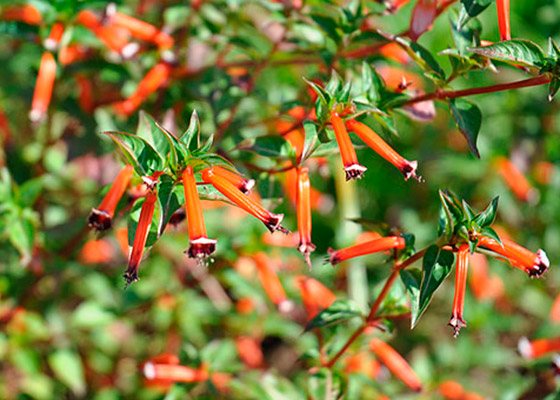

- Fertilize the soil with organic fertilizers. In this case, the kufeya will reach its maximum size already at the beginning of summer.
- Don't be afraid to prune your shrub regularly. From this it only becomes thicker and more magnificent. You can cut the kufeya at any time of the year. Designers successfully use this and form intricate plots from the crown of the bushes.
- Plant the shoots at least 35 centimeters apart.
- If dark spots suddenly appear on the leaves, then know that the roots are affected by a fungus. This happens due to excessive watering or prolonged rains. In this case, you can save the plant by using fungicidal preparations. These remedies can also fight powdery mildew.
- Spider mites, thrips, and scale insects occasionally attack the cigarette tree. You can get rid of spider mites with a soapy solution. After removing the afterbirth of insects, the bush must be sprinkled abundantly with water. For scale insects and thrips, a solution of potassium soap or insecticides will help.
- Finally, a very important piece of advice. In no case do not plant kufeya in places where drafts occur. Under their influence, the plant sheds its leaves.
How to grow a plant from seeds?
For many who wish to have such a plant as cufea (cuphea) on their plot or windowsill, its care and cultivation from seeds remains a mystery. Therefore, they are looking for such information in all sorts of sources.
This seed plant is easy to grow.They are sown in early spring in a pan with a special earthen mixture and lightly sprinkled with soil on top. The pallet prepared in this way is placed in a dark polyethylene bag or covered with thick paper. When the seeds begin to germinate, you need to transfer it to a light windowsill.
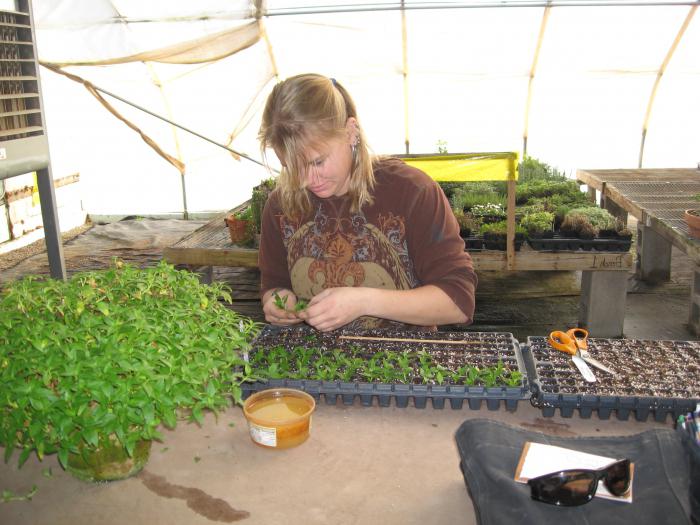

The grown seedlings are planted one at a time in small containers. Care must be taken to ensure that the soil does not dry out. After the seedlings grow up, you will need to select the strongest shoots and transplant them into separate pots, the diameter of which is at least 11 centimeters.
Common diseases
Kufa is quite resistant to diseases. Sometimes, with unregulated watering, it is affected by fungal diseases, rot. You will find a description of the main diseases of kufei and their treatment in the table.
Table - Diseases of kufei
| Disease | Signs | Treatment |
| Chlorosis (iron deficiency) | - The appearance of spots; - yellowing of leaves when only veins remain green | - Spraying with preparations with iron chelate |
| Gray rot (fungus) | - Decay of the root collar; - the formation of a gray fluffy bloom on the leaves | - Trimming the affected parts of the kufei - treatment with the drug "Fitosporin"; - transplant into a new sterile soil |
| Powdery mildew (fungus) | - Appearance of a whitish powdery bloom on the leaves; - yellowing, wilting or drying of the kufei | - Termination of spraying; - carrying out strong pruning; - spraying with any systemic fungicide |
Some popular types
Hyssopolis
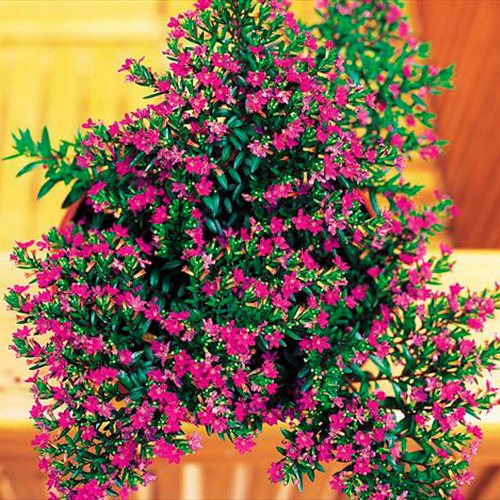

This type is characterized by very elastic branches. They do not break even in very strong winds. The kufeya hyssopifolia plant is thermophilic, therefore, if you live in the Central zone of Russia or, even more so, in the North, it makes no sense to plant it in the ground. Where to grow it? In pots, and during the warmer months, expose them to an open space.
Fiery red
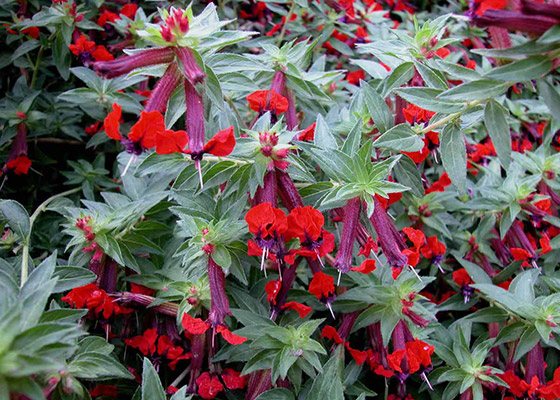

The variety is not only thermophilic, but also loves humid air. If you choose this kufeya, then grow it in the house and spray it regularly. This kufeya (gel) does not tolerate cold air.
Micro-petal
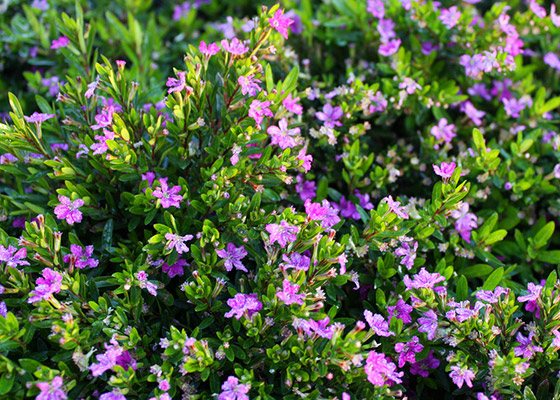

also called a candy bush. The bright pink flowers give off a fragrant and sweet-tasting juice. It attracts many bees and other pollinating insects. This plant is usually grown outdoors.
Lanceolate
Water kufeya
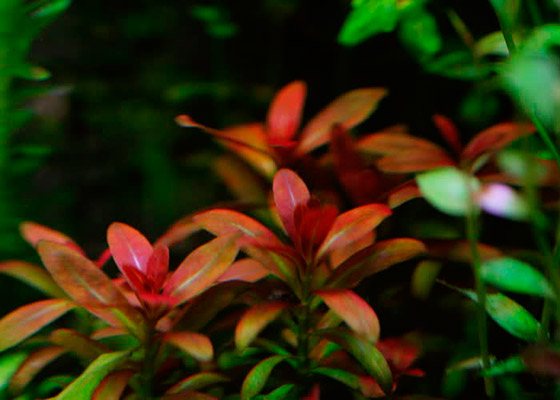

An aquarium plant, its content is even simpler.
Pale
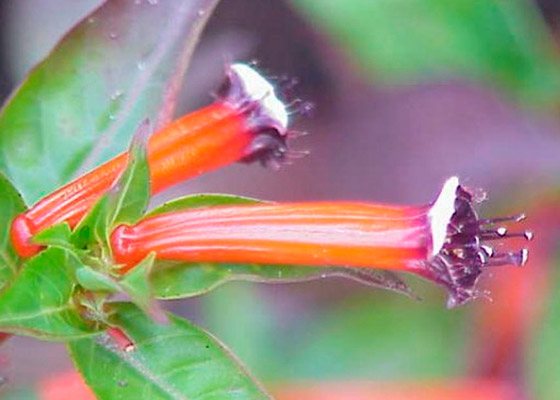

The variety can have corollas of white, pink or lilac flowers. Plant the plant in the most wind-protected place in the garden or on the balcony if it faces south.
Kufeya Llaveya "Shriracha" in garden design
The main area of application of kufei in design is container floriculture. You can use several bushes of kufei of the same color in a small container of salt. Or combine all three colors that the series represents.
The kufei bushes are well leafy from top to bottom, she does not have the problem of “bare legs”, so she does not need decorating plants in front. However, kufeya can go well with many popular perennials, for example: Bacopa, Calibrachoa, Bidense, Ipomoea sweet potato, Coleus and others. Due to its relatively high growth, it is planted in the center of the container, and on the sides it is supplemented with ampelous or undersized annuals.
Possible problems
All varieties of kufei are practically not affected by pests and diseases, so in this regard, the culture does not cause much concern. But there may be difficulties:
- if you do not water the plant in time, it can quickly wither;
- the culture should be formed and cut off the dried leaves and stems, otherwise the bush will lose its attractive appearance;
- bushes can lie in the wind;
- lack of proper lighting can significantly slow down growth or even lead to premature wilting;
- sometimes a whitefly attacks the culture;
- rarely, but the plant is affected by mold and root rot.
Temperature and lighting requirement
Kufeya is quite thermophilic, it needs moderate heating of the air.In summer, the temperature should be 22-25 degrees, and in winter - at least 12-18. Too cold air can be detrimental to the flower.
For good vegetative development, the flower needs bright sunlight. It is best to grow kufeya at home on the eastern, in extreme cases, on the western windows. Northern window sills are unfavorable to the plant, the flowering of which, due to a lack of light, will be defective, and the leaves will become dull.
Important! If the plant gets sunburn, the leaves will suddenly turn red.
Features of kufei Llaveya
Unlike other types of kufei, kufei Llavey (Cuphea llavea) has a slightly different flower shape. It, like the kufei familiar to many, has a long pipe, but at the end it diverges into six wavy corrugated petals.
If you look at the flowers from the front, you can see their strong resemblance to clarke or azalea. By the way, in North America, they noticed the similarity of this flower with the head of a bat, and in its homeland it has the nickname of the kufeya-bat.
Each inflorescence consists of several flowers, of which one to three are simultaneously open. In the evening and in cloudy weather, all the flowers fold their petals. Separate faded flowers do not spoil the general appearance of the plant and do not need to be removed.
Basic rules for keeping kufei at home
At home, for a plant such as kufeya, care, cultivation, watering, planting must be carried out in compliance with certain rules. If we consider them in more detail, then the following main directions can be distinguished:
- The plant needs moderate air humidity, so spraying the flower should be done from time to time.
- The transplant should be carried out annually, but only in the spring. The earthen mixture for kufei should consist of equal amounts of humus, peat, turf and leafy soil, to which ½ part of the sand is added. At the bottom of the dishes where the plant will be transplanted, drainage is mandatory.
- Top dressing is carried out with a mineral fertilizer intended for flowering indoor plants in the spring and summer. This procedure should be performed at least once every 2 weeks.
- Pruning in the spring is the main step in caring for a plant such as kufeya. Pruning consists in transforming the crown of this flowering dwarf shrub to the desired shape and size.
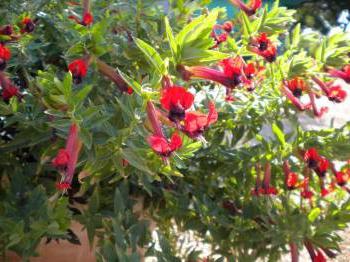

The most careful formation of the crown requires such a subspecies of this plant as kufeya hyssopolis. After you have spent it in the spring, in the summer it will be enough to maintain the created shape by periodic pinching, produced at the tips of the shoots. The best crown shapes for this plant are spherical and pyramidal.
Decorative floriculture
The passion for flowers leads almost all lovers to search for new plants, which so far grow from garden plots in few places. Everyone wants his outfit to be different from those around him in a certain uniqueness. For this reason, every year it becomes more and more in demand such a flower plant, which is practically unknown until now, such as kufeya.
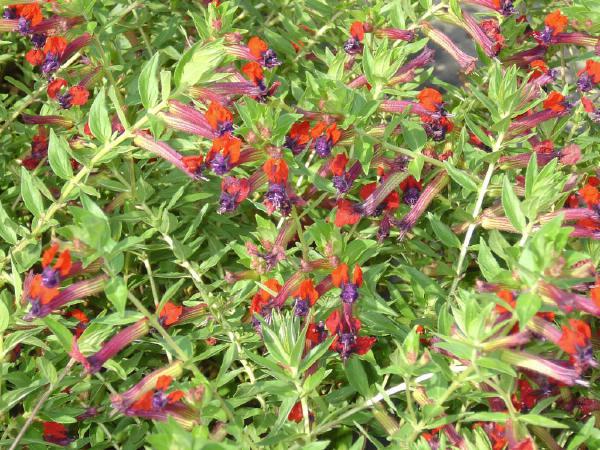

Care, species, reproduction, planting rules for this plant are questions, the answers to which are still not fully known to anyone. Therefore, it is worth talking about this topic in more detail. This will save many flower growers from doubts about whether it is worth cultivating such a magnificent plant as kufei on the site or at home.
Difficulties in growing kufei
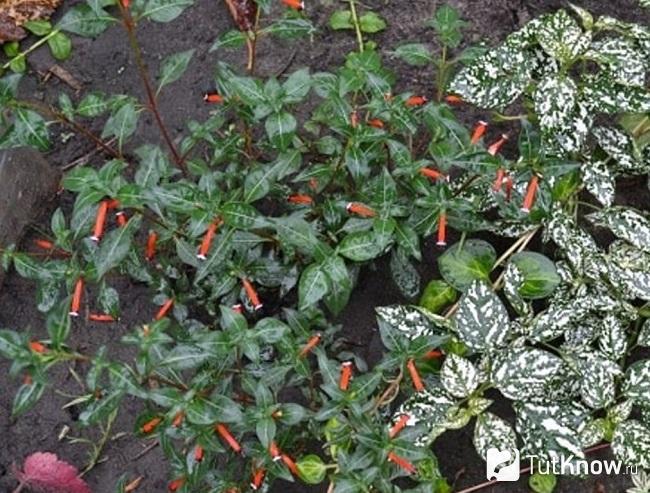

When growing this plant, problems can arise when the soil is flooded and high humidity, then dark spots appear on the stems and leaves, which have provoked gray rot or various fungal diseases. If such symptoms are noticed, then treatment with fungicidal preparations should be carried out.
Of the pests of kufei, the whitefly, spider mite or aphid annoy them.If a pest is found, then the deciduous mass should be sprayed with insecticidal agents.
If the plant is exposed to a draft, it can cause foliage to fall.
1. Seven Secrets of Success:
| 1. Growing temperature: during the growing season, the air temperature should be 18 - 21 degrees Celsius. For kufei, a dormant period begins in the winter months, which the plants must spend at a temperature of 10-13 degrees Celsius. |
| 2. Lighting: in the morning and evening hours, the flower can take sun baths for 2 - 3 hours daily. During the day, plants should be protected from sun exposure. |
| 3. Watering and humidity: In spring and summer, watering should be abundant, with listening to the soil surface to a depth of 2 - 3 cm. In autumn and winter, watering, especially when kept in cool conditions, is reduced to a minimum. Air humidity is increased only when the air temperature exceeds 18 degrees Celsius. |
| 4. Pruning: kufeya is pruned in late winter or early spring to maintain a beautiful and compact shape. |
| 5. Priming: kufeya likes organic-rich substrates with a loose and light texture, the flower prefers soils with excellent drainage. |
| 6. Top dressing: from spring to autumn, the flower is fed 2 times a month with fertilizers for flowering plants. In the fall, top dressing is reduced to naught and resumed only in the spring, with the appearance of small leaves. |
| 7. Reproduction: Kufa propagates by sowing seeds in spring or by rooting stem cuttings in spring and summer. |
Botanical name: Cuphea.
Kufa plant - family... Derbennikovye.
Origin... Mexico, Jamaica.


Description. Kufeya - a large genus, consisting of 250 annual, or perennial evergreen, low-growing shrubs. Leaves are leathery, lanceolate, dark green, up to 5 cm long, very densely cover the stems. Flowers appear on the tops of the branches very abundantly, they consist of accrete petals, forming a long tube - up to 3 cm, purple, red, white, sometimes two-colored - the tip of the tube is painted in a contrasting shade, single, axillary. Variegated varieties are available.
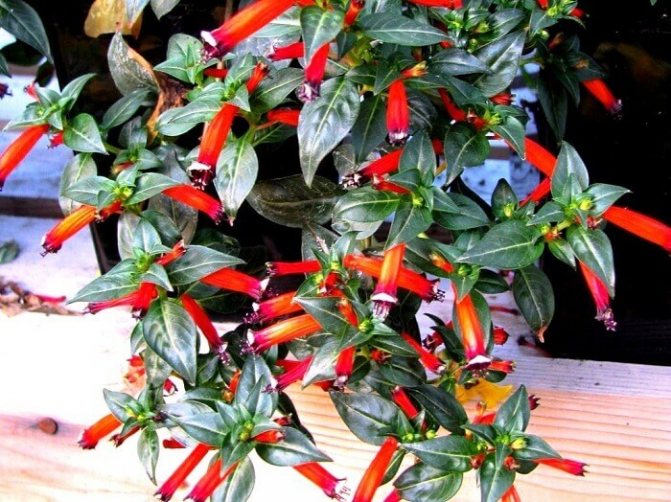

Height... In culture, it does not exceed 60 cm, it grows quickly.
Reproduction and planting of kufei with your own hands


Get a new plant with beautiful flowers, perhaps by cutting or sowing seeds.
When grafting, the blanks are cut in March-April. The length of the cutting should be within 7–8 cm, the lower leaves are recommended to be removed, and the cut should be treated with a root formation stimulator (root or heteroauxin). The rooting mixture is made up of sand and peat. Cuttings planted in pots are covered with a plastic bag or placed under a glass container. Rooting is best done at room heat. As soon as roots appear on the cuttings (that is, new leaves begin to form), then transplantation is performed in separate containers with a suitable substrate. But in order to get a fluffier bush, 3-4 cuttings should be planted in one pot.
When seed propagation, it must be borne in mind that seed germination is rather low. Seed material is spread over the surface of peat-sandy soil, poured into a bowl, slightly pressed into the soil. Do not sprinkle with another layer of substrate. The container with crops is covered with a piece of glass or a plastic bag. They put the bowl in a warm place (with a heat reading of 21 degrees) with diffused lighting. Do not forget to air the seedlings every day and moisten it when the soil dries.
When the seedlings appear (after 7-10 days), the shelter is removed. When a pair of true leaves on plants forms, they are dived into separate pots. It is important to carry out the formation of the crown on time; for this, pinching is carried out on the seedlings of the required height, when the third pair of leaves unfolds.
If the plants with any method of reproduction have grown sufficiently strong, then they can be planted in open ground when the threat of spring morning frosts has passed. On a flower bed, at least 30–35 cm should be left between young kufei. In this case, flowering can already be expected at the end of July or by mid-summer. Plants will delight with their flowers until the first frost.
3. Varieties:
3.1.Cuphea hyssopifolia - cuphea hyssopifolia
Compact evergreen shrub up to 60 cm high with thin, green or brownish, abundantly branching stems. Leaves are green, lanceolate, glossy, on short petioles, arranged in opposite pairs. During the flowering period, the plant forms small single, axillary, pink, crimson or white flowers in the upper part of the stems.
↑ Up,
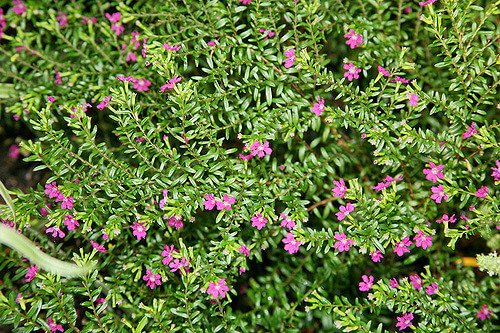

A little about the disadvantages of kufei Llavey
As a result of the cultivation, I was pleased with this hybrid series of Llaveya kufei. First of all, it helps to add variety to the usual sets of summer cakes, which have been grown by gardeners from year to year for more than a decade and seem mundane and slightly banal.
But still, there is one small "but": be prepared that kufeya will not look like advertising pictures of seed producers. To tell the truth, it disappointed me a little.
If you look at the image of kufei in professional photos, then you will see squat bushes, about 20 centimeters high, covered with an abundance of flowers (the approximate ratio of foliage and inflorescences is 50 to 50%). In fact, kufei grows much taller (30-40 centimeters) and there are not so many relatively rich foliage of inflorescences. In blooming, the kufei Llaveya reminded me even more of a shrub than an annual flower.
Such a discrepancy in the habit of a real flower is caused by the fact that professionals involved in the cultivation of flowers for sale use a large number of retardants for kufei at all stages of growing seedlings. And these substances, as you know, inhibit the growth of shoots in height. Thus, flowers that do not have a very attractive habit are shorter and more compact.
Usually, amateur gardeners use retardants only in case of a threat of strong stretching and overgrowing of seedlings, but not everyone is ready to constantly stuff a flower with them in order to change its appearance.
Therefore, in order to have an idea of what "Shiriracha" kufea looks like, grown in a natural way, and to understand whether you like it, it is better to look for photos of ordinary florists. And it is best to try to grow plants on your own for at least one season in order to see it live.
Photo
Kufa flower photo:
Landing
As already mentioned, almost all varieties of kufei are very fond of warmth. Therefore, you should carefully consider the choice of a suitable site for planting in open ground. It is recommended to choose a well-lit place. Unlike many other ornamental plants, direct sunlight is one of the necessary criteria for the normal development of shrubs. You can plant kufeya on a slightly shaded area, but you need to understand that there will not be full development as such, and growth will slow down several times. It is better to plant the plant in higher elevations, this is necessary to avoid stagnant water, as is often the case in lowlands. For the same reason, it is best to resort to using drainage when planting. Kufeya is usually planted at the end of spring.
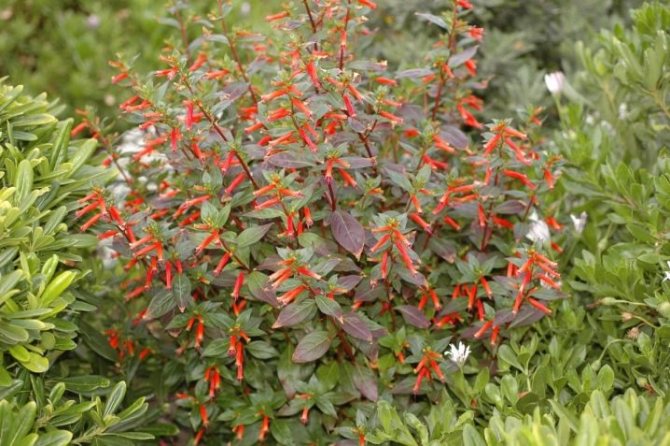

The plant is very well accepted in fertile soils. For warm regions, kufeya is ideal if there is an abnormal heat outside the window, this will in no way harm the ground cover.
So, let's look at the basic rules for planting kufei.
- At the first stage, the soil needs preparation. Before planting, it is recommended to treat the land with fertilizer in the form of humus. A bucket will be enough. Wood ash can be used as an additional component. You will need much less of it. With such proportions, half a glass will be enough.After that, we mix the whole mixture with the soil by digging and leveling the site.
- There are also other fertilizers, thanks to which the plant can take root firmly in the soil. Organic matter must contain components such as potassium, nitrogen and phosphorus. They contribute to the efficient growth of kufei. A mixture based on nitroammophoska is excellent for such characteristics. One tablespoon will be enough per square meter of land area.
- Small holes should be dug, the seedlings are trans-shipped. The distance between the bushes should be at least 20 centimeters, and between the rows - twice as much.
Features of growing a plant in our latitudes
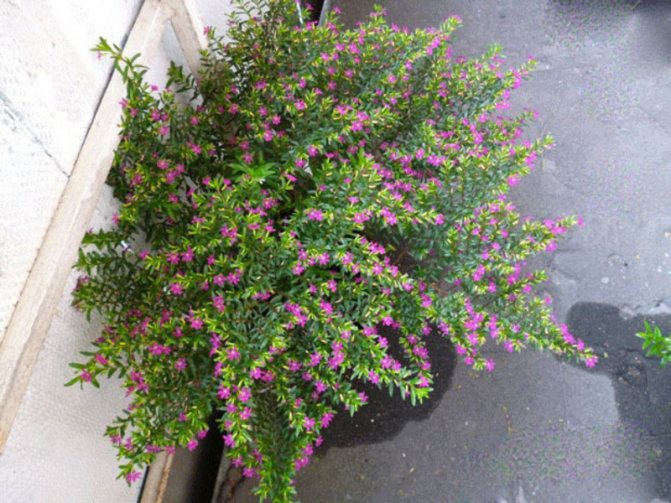

The birthplace of kufei is considered to be Mexico and the countries of Central America. There, the plant grows in abundance and easily tolerates the local climate. Some varieties are also found in Greece. It is to the Greek language that the flower owes its name: in Greek, something snaggy, crooked is called kufei. However, thanks to the voluminous lush deciduous bush, the tortuosity of the stem of this plant is almost invisible. It is widely used not only as a separate decorative flower, but also as an accent in the landscape design of the site.
How to apply in garden design: photo
The culture is successfully used when creating individual flower beds, alpine slides and as borders to paths or children's and sports grounds.
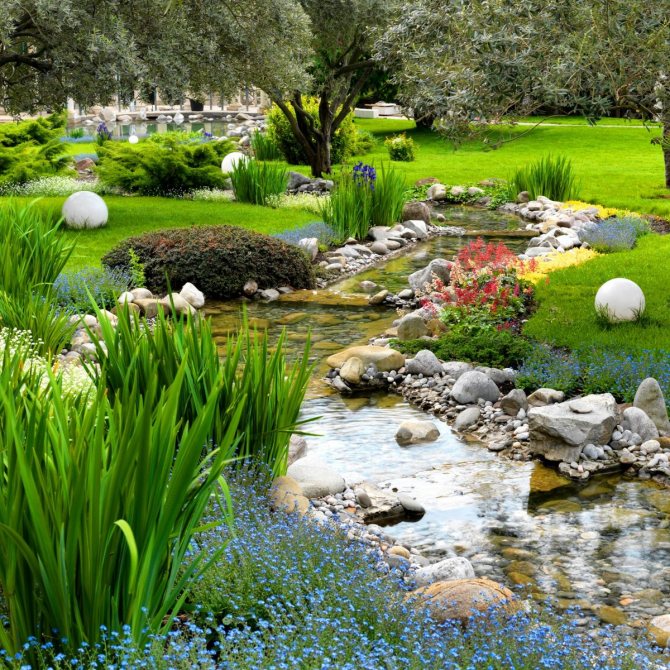

Most types of kufei in natural conditions like watery soil, even waterlogged, therefore, in garden plots, this culture is often planted around the perimeter of artificial ponds or waterfalls.
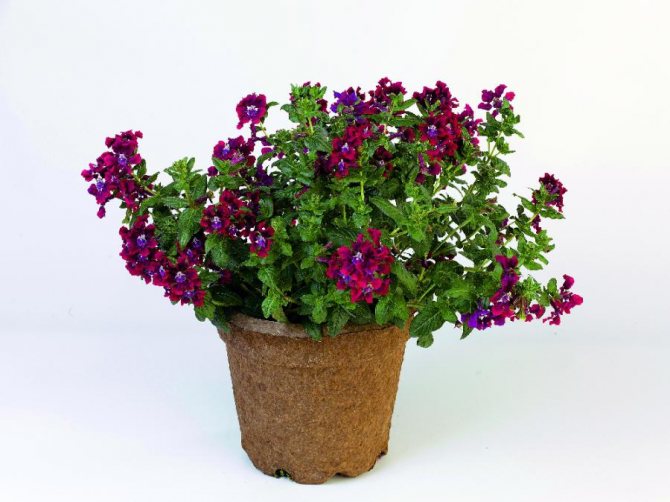

It can also be successfully grown in pots, flower pots, on balconies and outdoors in the garden.
True, as already noted, this culture does not tolerate our winters and in most regions dies with the onset of frost. However, in the southern latitudes it winters (so to speak) well. However, many gardeners have adapted to carry flowers into the garden in large flowerpots for the summer, and towards the end of autumn they bring them into a room where the plant calmly tolerates the winter season.
So, kufeya and in the northern latitudes becomes perennial. With a favorable temperature regime, the plant can begin to bloom as early as March, and this beauty continues until October.
Description of the plant
Kufeya is a shrub from the Derbennikovye family, all representatives of which are distinguished by their original appearance. Of the plants well known to most flower growers, pomegranate and lagerstroemeria can be mentioned. Kufeya is more compact. The foliage of the plant is small, delicate, light green. The size of the bush is no more than 40-60 cm, it is perfect for landscaping rooms. Flowers are remarkable. They are rod-shaped and usually have a glowing red color.
For the shape of flowers in the West, kufei is called Cigar Flower or Cigar Plant - a flower-cigarette.
The homeland of the plant is Mexico, Jamaica. The flowers of the kufei attract hummingbirds. Some species are excellent honey plants, fragrant, used in perfumery. A valuable oil is squeezed out of the seeds, similar in composition and properties to coconut oil.
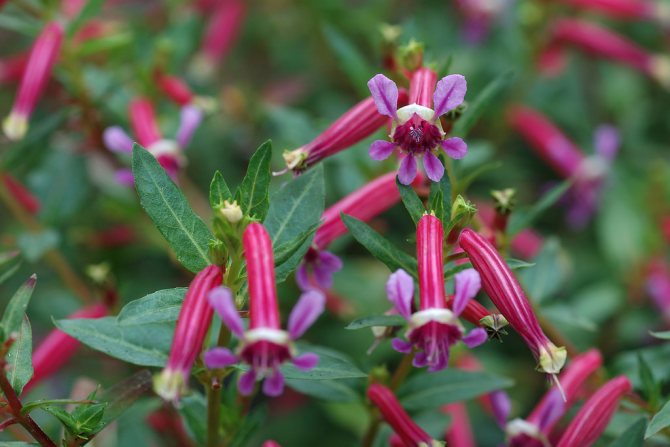

Kufei flowers are shaped like a cigarette
Important characteristics:
- An evergreen perennial, often grown as an annual in the middle lane.
- In the climatic conditions of Russia, it does not winter outdoors.
- Some species grow relatively slowly.
- It lends itself well to shaping and pruning.
- Blooms profusely from June to November. From December to the end of spring - a dormant period. With enough light in winter, it can bloom throughout the year.
- Beginners will require careful care.
Types and varieties of kufei
There are about 270 species in the kufei genus, so do not be surprised if you see very different plants under this name. It can be shrubs and herbaceous perennials, compact, tall, with erect stems or ampelous, with different flowers.
In decorative floriculture, two groups of varieties have taken root.These are tall plants for open field and more compact - suitable for containers and pots. However, there is no clear border between the groups, all kufeis feel great in the container culture. However, as a rule, representatives of the second group can be found in Russian nurseries. These include kufeya micro-petal, fiery red, hyssopolis, sticky.
Fiery red kufea (Cuphea ignea)
In indoor culture, it is a compact shrub up to 40 cm tall, with rather flexible stems. Can be formed as a bush or as an ampelous plant. Leaves are smooth, green, narrow, 5-6 cm, flowers are flaming red tubes with bent black-violet petals 2-3 cm in length. A small white edging is visible at the ends of the petals. Flowers really evoke associations with smoldering cigarettes.
The species has taken root perfectly in decorative floriculture, not only due to its unusual bright flowers, but also due to its general qualities. The fiery red kufeya is actively growing, branching well. Without pinching the lash, the plants will be very long, which is convenient when using the culture on balconies, in hanging pots or as a ground cover. Blooms profusely and continuously, from mid-July to late autumn. Due to its rapid growth, it is often grown as an annual - no need to spend energy on organizing wintering.
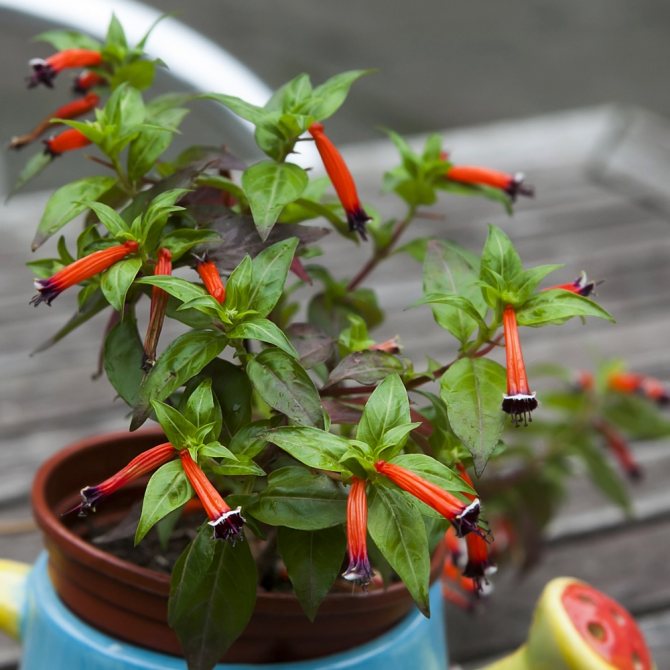

Fire-red kufeya is widely used in floriculture.
Pale kufei (Cuphea pallida) is probably an alternative name for fiery red kufei. In official sources, for example, in the Plant List database, there is no such name, although it is mentioned in domestic publications.
Cufea hyssopifolia (Cuphea hyssopifolia)
Hyssopolis kufeya enchants with its fresh appearance. It is with her that many begin to interest in this culture. Small bush - up to 50 cm in height. The shoots are highly branching, the leaves are small, frequent, bright green, up to 2-3 cm in length. The flowers are not typical for kufei in shape - they have a pronounced corolla up to 1 cm in diameter with well-readable petals of the same size, very abundant. The color is bright, lilac-pink. Flowers do not give seeds, so this species is propagated by cuttings. The plant lends itself well to shaping, allowing you to create clear, neat forms.
In German-speaking countries, it is called Japanische Scheinmyrth (Japanese pseudomirt). The small and shiny leaves of kufei hyssopolis and the plant's pliability to pruning really evoke associations with myrtle. In the USA, it is called Mexican Heather - Mexican heather, for its origin and general appearance, reminiscent of heather in its exquisite colors.
Koufea Hyssopolis Alba has charming numerous white flowers and shoots quickly woody at the base. Good for making bonsai.
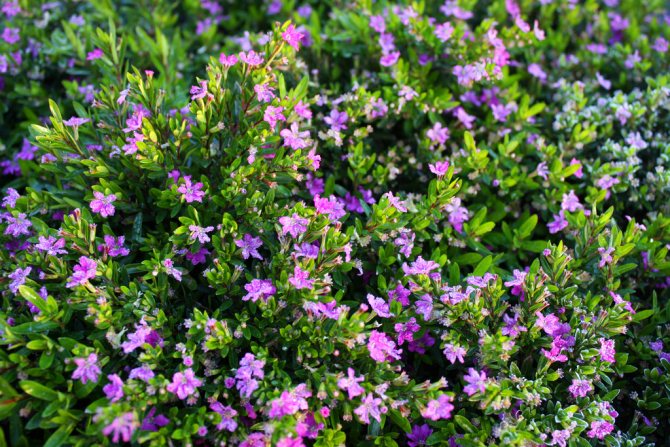

Flowers of kufei hyssopolis do not give seeds
Cuphea Micropetala
The height of micro-petal kufei in a pot culture is 30–40 cm; it is a bright shrub with narrow leaves and candelabra of yellow-red flowers. In the West, the plant is called Candy Corn Plant, which means "Candy Corn Plant." The flowers do resemble the rather popular Candy Corn cone shaped like corn kernels.
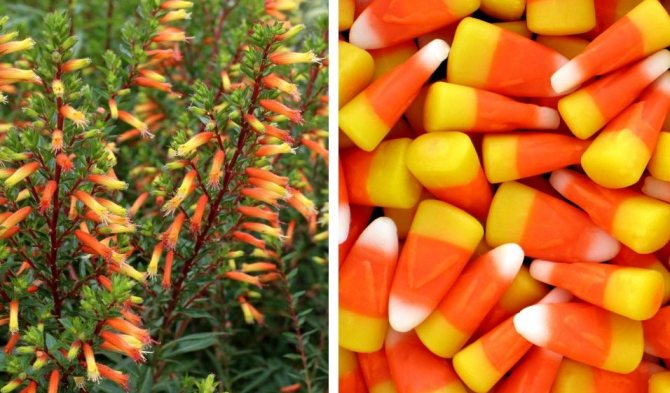

The flowers of the micro-petal kufei resemble Candy Corn, popular in the west.
In open ground, it can reach a meter in height. Its long and sturdy stems dotted with glowing flowers make it look spectacular in the garden.
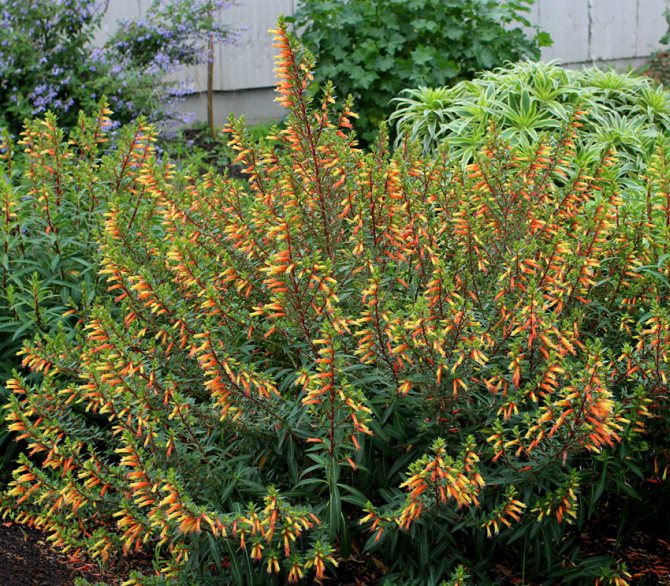

Florists prefer to grow micro-petal kufeya in the open air.
Sticky Kufa (Cuphea viscosissima)
Abroad, this species is called Blue waxweed (blue wax) for its brightly colored flowers and a wax coating on the stems and leaves. The flowers have an original exotic shape, reminiscent of orchid flowers. Painted in a very spectacular dark burgundy velvet color, small, abundant. The plant is relatively tall - up to half a meter in height.Unpretentious, feels good outdoors even in the Urals and Siberia, although it is still a huge rarity.
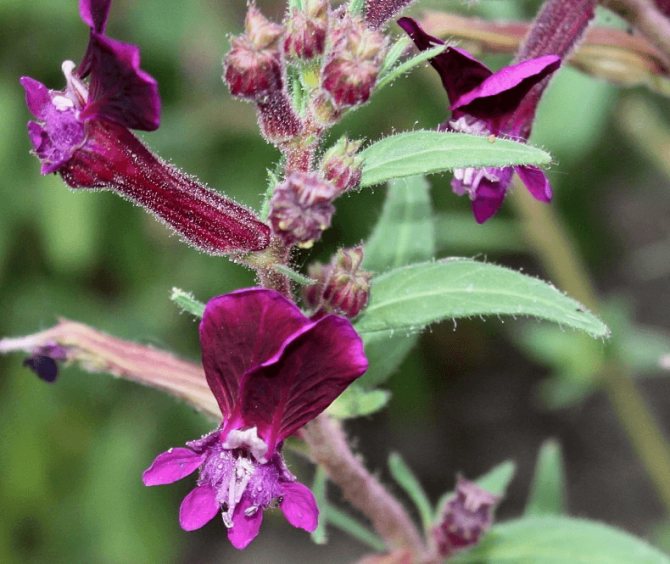

The flowers of the sticky kufei are distinguished by their spectacular color.
Small herbaceous hedges with rather high protective properties from uninvited guests, for example, neighboring animals, are excellently obtained from this type of kufei. Few people want to climb into thickets of plants covered with a sticky bloom.
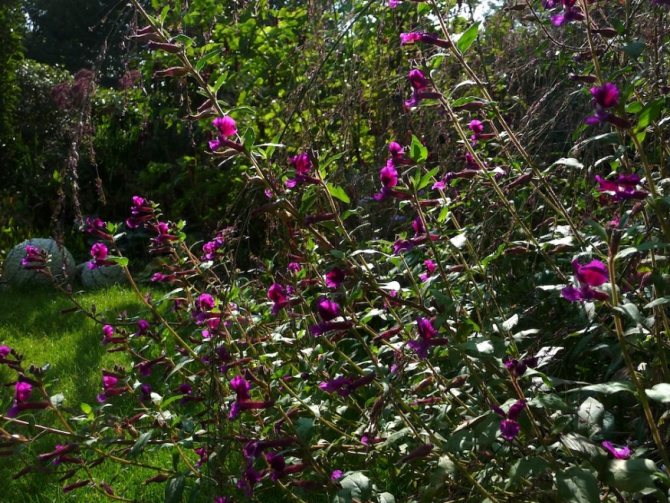

The sticky kufeya can be used outdoors as a wide curb
Rarer varieties of kufei
The types of kufei listed below are more suitable for open ground. They can be safely recommended for the southern regions of Russia. In the middle lane, these plants can also be grown in the garden, although you will have to pay more attention to them. In Russia, these species are rare, but their agricultural technology when grown in containers is no more difficult than that of others.
Creeping coffee, or prostrate (Cuphea procumbens)
The bushes of the kufei prostrate are rather high, they can reach half a meter, they branch strongly, the flowers are very bright, lilac-purple. They can also be white. The beginning of flowering is mid-July. If grown in seedlings, it can bloom in late June. Flowering lasts up to 3 months.
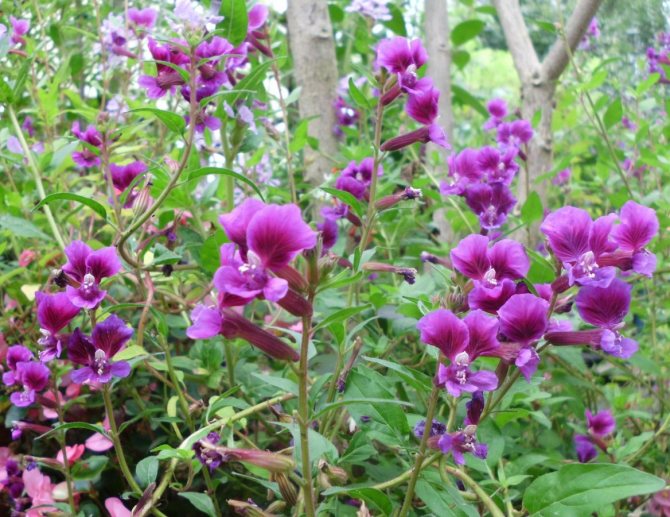

Creeping kufea is more difficult to cultivate than other species
Cuphea miniata Firefly
Kufeya Firefly, that is, the Burning Fire, is the result of crossing the kufei lavei and the prostrate one. Prized for its gorgeous bright red flowers that instantly create a juicy blotch in the garden. It is grown as an ampelous or flower bed annual plant. Very popular in the West.
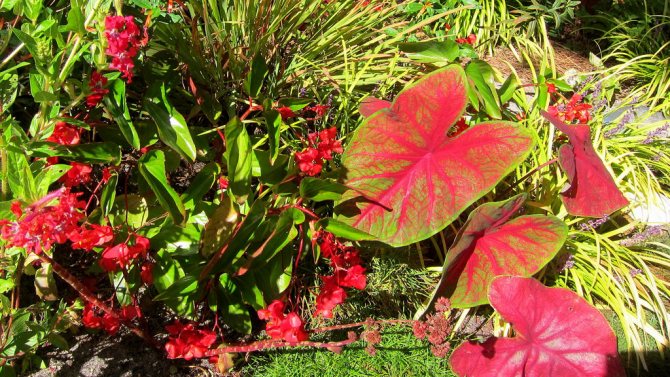

Caladium Brandywine and kufeya Firefly form an exotic composition
Kufhea lavea (Сuphea llavea)
Herbaceous shrub up to 60 cm in height. The flowers are very bright, abundant, have two glowing scarlet bent petals on a purple tubular base. A luxurious decoration for a flower garden, but very rare in Russia.
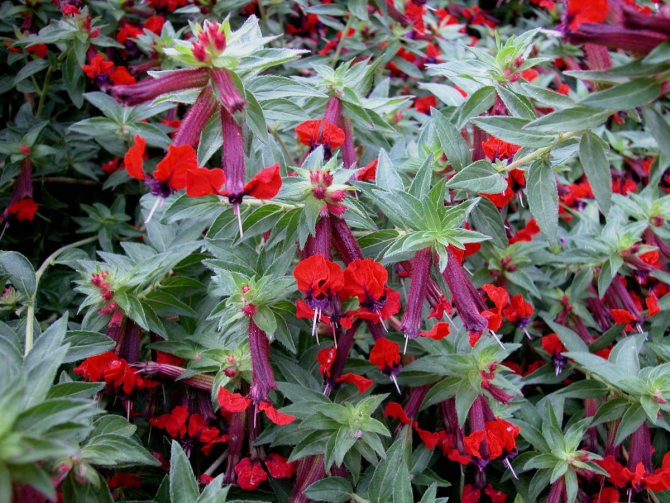

The flowers of kufei lavey are very spectacular: the combination of red and purple looks like a king
Lanceolate kufea, or lanceolate (Сuphea lanceolata)
This is a tall annual, bushes reach 70–90 cm in height. The stems are pubescent, the leaves are light green, narrow and sparse. The flowers are saturated dark purple, tubular, long, up to 3 cm, collected in candelabra inflorescences. Blooms in late July. There are several varietal varieties of the species, for example, Cuphea x purpurea, or Kufhea lanceolate purple, with high stems. The flowers are crimson with two petals of a dark purple color, on which veins are visible. A very showy, exotic, profusely flowering variety.
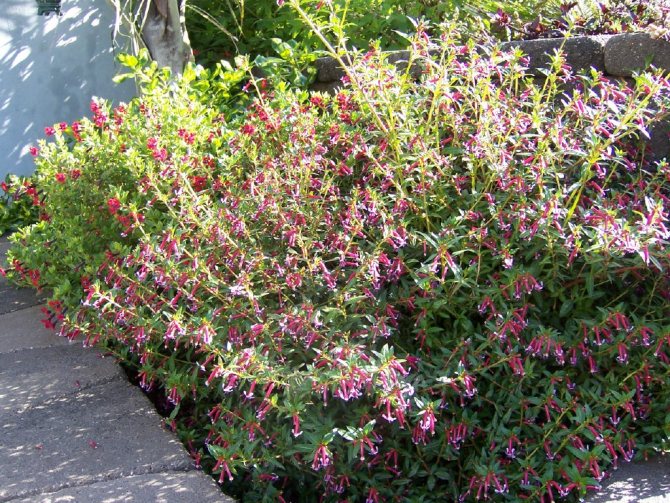

Lanceolate kufea is often found in the southern regions.
Hyssopolis kufea, fiery red and other types
In the wild, there are more than 200-250 species per flower, some have been bred by breeders.
| View | Leaves | Flowers |
| Hyssopolis. | Thick, elongated, bright green. | Numerous small, white, pink, scarlet, lilac. |
| Fiery red. | Small, light green. | Intense red, at the end of the gradient in dark burgundy, in the form of a tube. |
| Micro-petal. | Small, long, light. | Tubular, red-yellow. |
| Spread out. | Thick, light. | White, lilac. |
| A blazing bonfire. Selection type. | Dark. | Bright scarlet. |
| Pale. | Dark, thick. | Small, dark cherry. |
| Cinnabar red. | Small, rare, light. | Lilac-white, large, few-petaled. |
| Lanceolate. | Light green. | In the form of a scarlet tube with lilac, white petals. |
| Water. | Small, located opposite each other. The plate is rounded, the top color is red with an admixture of green, the bottom is green. When the plant grows and gets from the aquatic environment to the air, the leaves change. The scarlet color disappears, the shape stretches. | In favorable conditions, shoots an arrow with a white flower. |
Typical pests
We have to deal with pests more often. Delicate leaves of kufei are often affected by aphids, whiteflies, spider mites.Detailed information about pests, signs of their appearance and methods of control can be found in the table.
Table - Pests of kufei
| Insect | Signs | Necessary measures |
| Whitefly | - The appearance of small white flying insects on the plant; - detection of a colony of larvae on the back of the leaves; - withering of kufei, stunting | - Treatment of kufei with preparations "Aktellik", "Inta-Vir", until the complete disappearance of insects; - preventive treatments with the same means |
| Spider mite | - The appearance of small yellowish dots on the leaves; - detection of a thin web on the leaves of kufei; - yellowing and falling leaves | - Washing kufei with a solution of potassium soap; - spraying the plant with Aktara; - increasing air humidity by any means |
| Shield | - Detection of insects with a convex brown shell on the leaves; - covering the leaves of kufei with a sticky bloom; - the appearance of a sooty fungus | - Removal of scale insects from a plant mechanically; - wiping places where insects accumulate with alcohol, rinsing with soapy water; - spraying with "Inta-vir" |
| Thrips | - Deformation of leaves of kufei, covering with a silvery bloom; - shedding of pollen from flowers; - detection on leaves of black dots, on flowers - holes | - Bathing kufei under a warm shower; - spraying with insecticide for flowers |
| Nematodes | - Damage to the root system of kufei; - deformation, curling of leaves, the appearance of spots | - Destruction of the infected plant |
| Aphid | - Twisting the tops of young shoots of kufei; - detection of sticky, sugary plaque on the leaves; - stop the bush in growth, wilting of the plant | - Bathing a flower in the shower using a soapy solution; - spraying the leaves with an infusion of tobacco dust or a preparation containing permethrin |
Caring for kufei in a pot is a simple and interesting activity. Its main advantage is long and abundant flowering. Unpretentiousness and high decorativeness make it an excellent decoration for any interior.
Tips for growing kufei from experienced florists
- In the open field in our region it grows like an annual. Therefore, at the end of the season, in autumn, the vegetative growth of the plant stops, and new buds no longer appear. If you want to preserve the kufeya, it must be provided with wintering in a cool room at a temperature of at least 5 degrees, and propagated by cuttings of young shoots in the spring.
- For the winter, it is recommended to take room kufeya to a cool room, as far as possible from radiators. Watering should be regular but moderate. The soil in the pot should be slightly damp. At the end of winter, you need to shorten the branches by a third to stimulate the growth of new shoots.
- When the pot is in a draft, the kufeya can shed its leaves.


Kufeya is an exotic flowering shrub that attracts attention with bright unusual flowers. The plant grows remarkably both indoors in pots, and in a summer cottage in the open field or in containers. Observing the necessary rules for caring for an exotic beauty, you will be able to enjoy the unusually luxurious flowering of kufei on the windowsill or in the garden for a long time.
General information about the plant
The beautiful kufea plant has Mexican roots and a Greek name. The inhabitants of Jamaica were the first to cultivate this shrub more than 30 years ago; today, about 200 plant species are known. Kufeya is a representative of the Derbennikov family. There are 2 types of plants:
- annual
- biennial
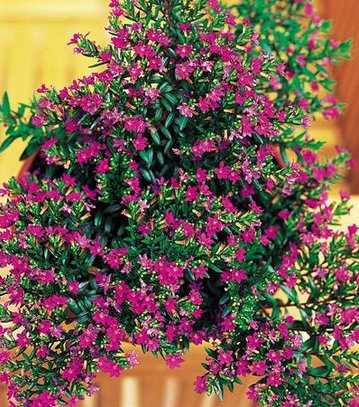

They grow kufeya for decorating balconies and loggias, in pots and containers. Also, the plant perfectly adapts to growing in open ground, for example, as a curb. The flowering period of kufei is quite long: from the beginning of summer to the first frost. The plant should be planted in a place where there will be partial shade in the midday heat. The soil needs light, loose, while sufficiently nutritious.In order for the plant to delight you with its flowering all season, it is important to organize high-quality regular watering. Do not use rainwater for irrigation, as it may contain harmful substances. The best option is warm water. Kufa propagates in two ways: cuttings and seeds. If you grow a perennial variety of kufei, then for the winter period the plant bush must be dug up and transplanted into a pot so that it overwinters indoors in winter. The plant requires feeding. For these purposes, mineral fertilizers are used. The regularity of the feeding process is every 2 weeks. It should be fed in April to August. Outwardly, the flower-tubules of the plant resemble a smoldering cigarette, therefore, the kufeya is sometimes called a "cigarette holder". To make the plant beautiful, it is advisable to pluck and cut it after flowering.
Breeding kufei
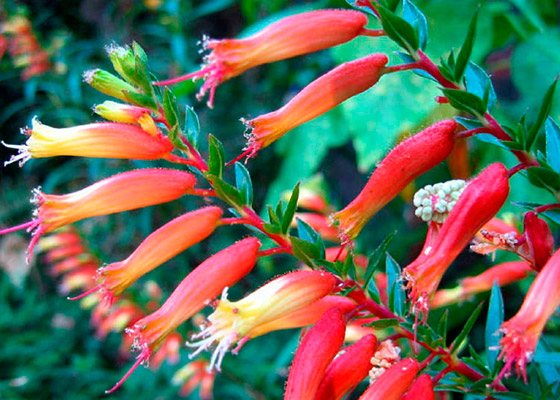

Growing this plant is not difficult. You can buy seeds at the store. Interestingly, a 1 gram sachet holds 300 seeds! This amount will be enough to decorate a square of decent size.
Germinate the seeds at the very end of winter, so that by the end of May, the seedlings can already be planted in the ground. Germination is done in the usual way without any special features. Spread the seeds evenly over the soil in a container and water regularly. No other worries are required when growing from seed.
When the weather is warm, plant the seedlings in the ground. Consider the local climate. Either way, find a warm place with no wind. If there are cold days in your area in the summer, then it would be better to plant the seedlings in deep wide pots. In bad weather, you can always bring a bush into the house, and when it gets warmer, put it back into the garden.
You can also propagate a cigarette tree by cuttings. Usually this method is only used when growing a flower indoors. With the cuttings propagation method, the first flowers on the bush will appear 6-9 months after rooting.
Interesting facts about kufei
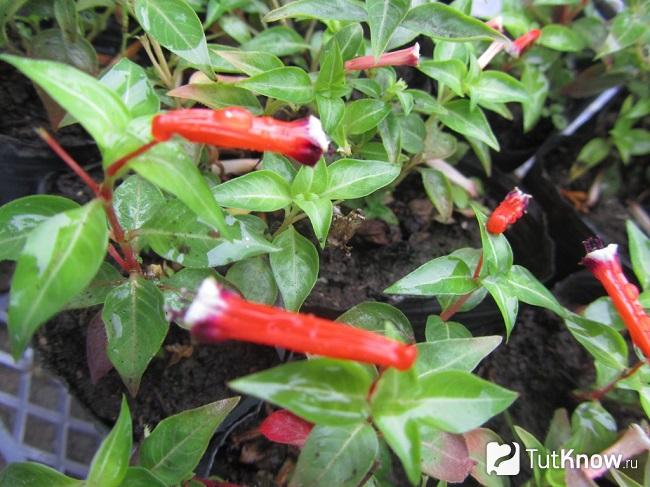

There are tropical varieties of kufei, which are grown only in order to obtain oil from the seed, which in its properties is very similar to coconut or palm oil. Also, seeds are used as raw materials for the production of laurel acid. Many other species are cultivated for their highly decorative appearance, and the plant also serves as an excellent honey plant. The flowers of the kufei can attract hummingbirds.
There is a belief that if you place this flower indoors, then it is able to unite people. It is often recommended to put a kufeya in office premises, so that it helps to establish contacts with employees. In the house where this delicate plant blooms, there is always a sensitive atmosphere full of benevolence.

